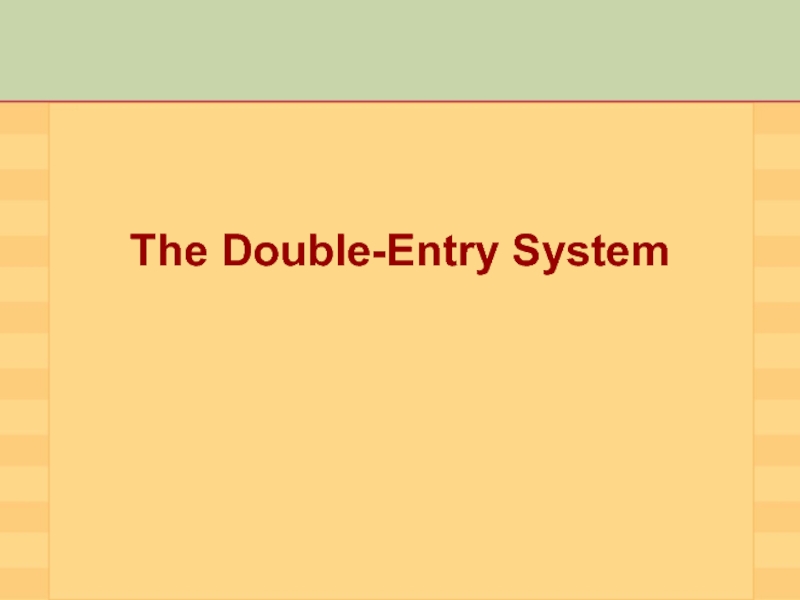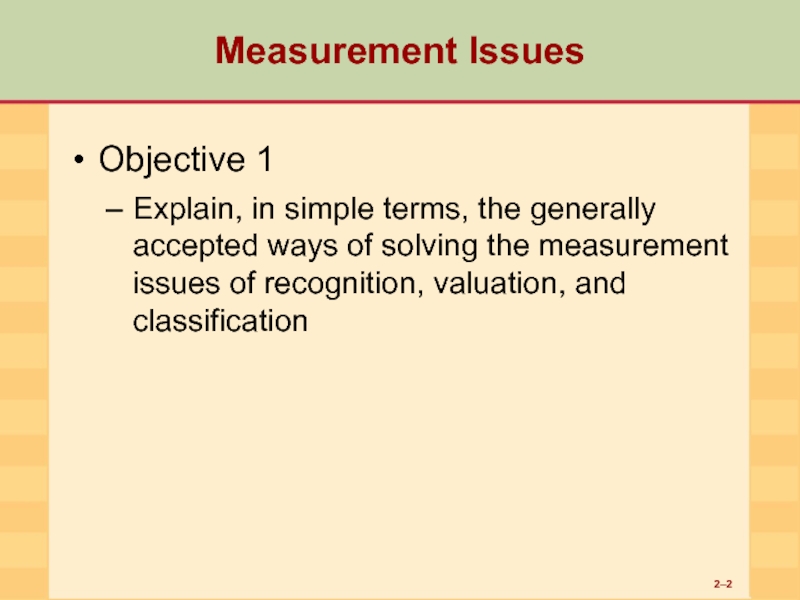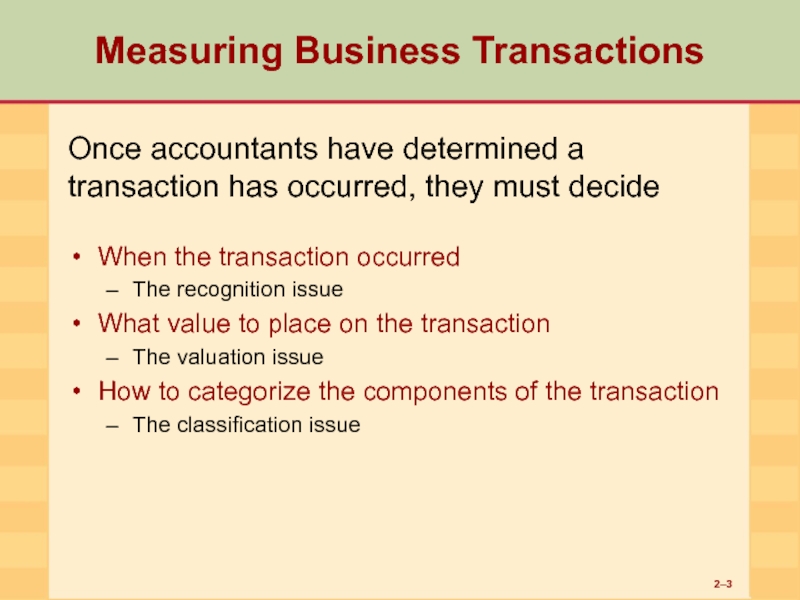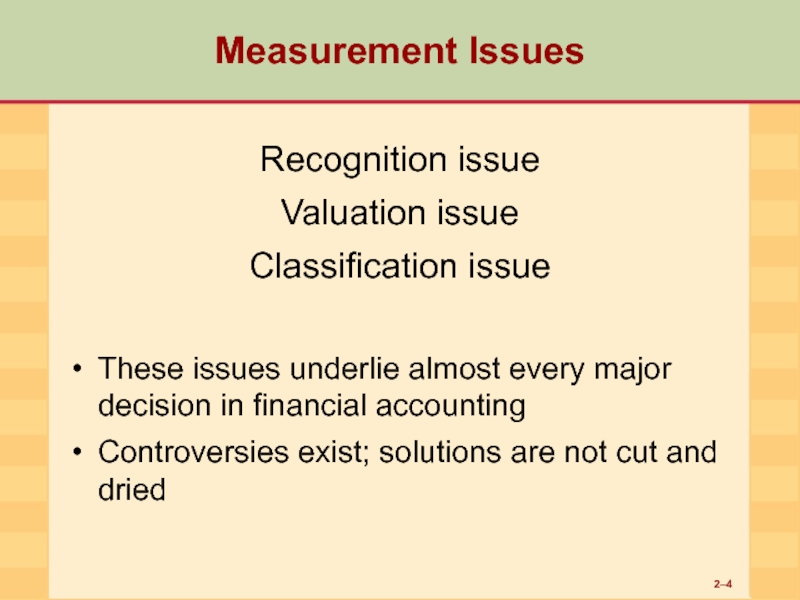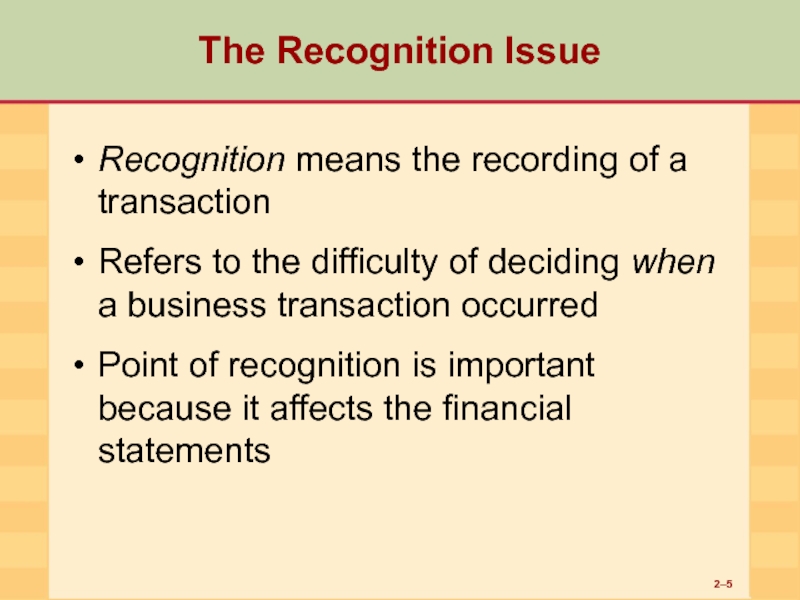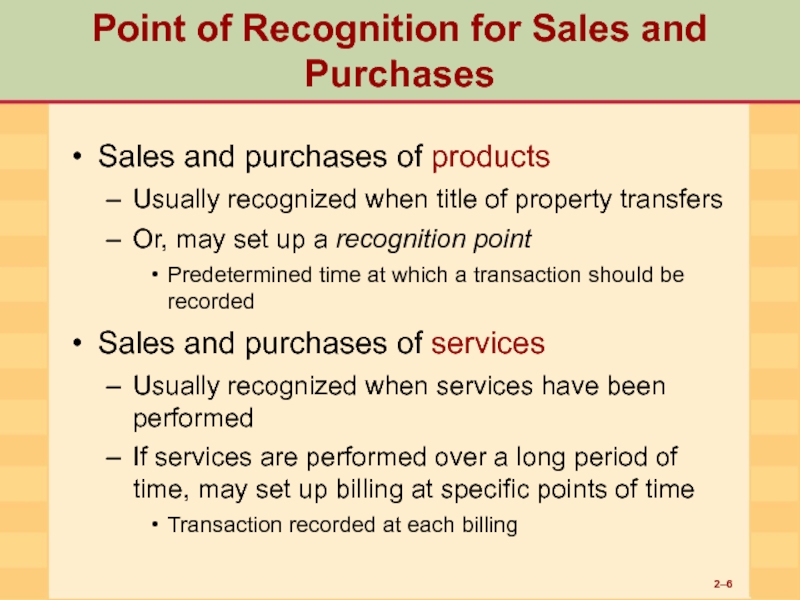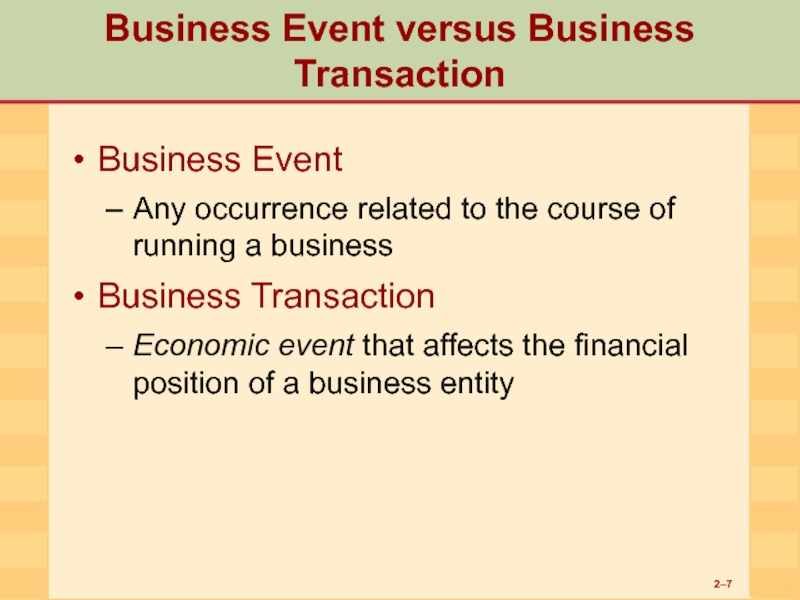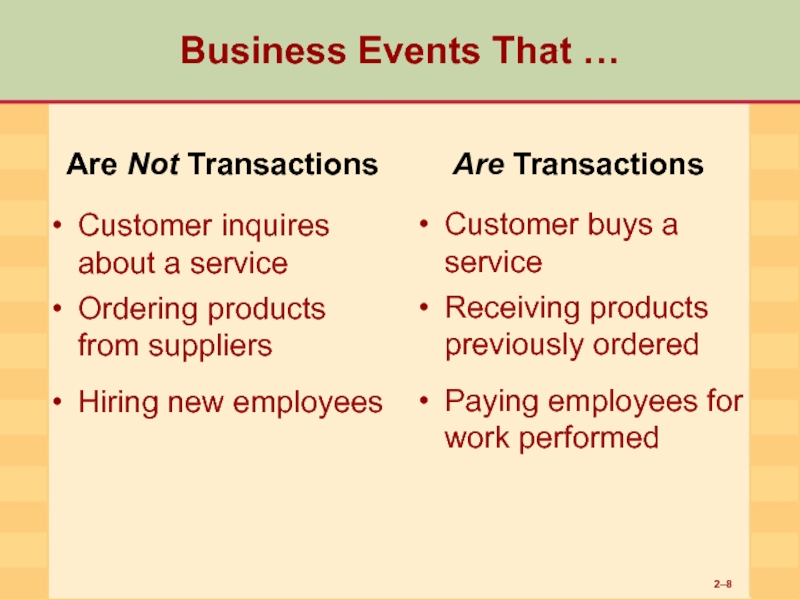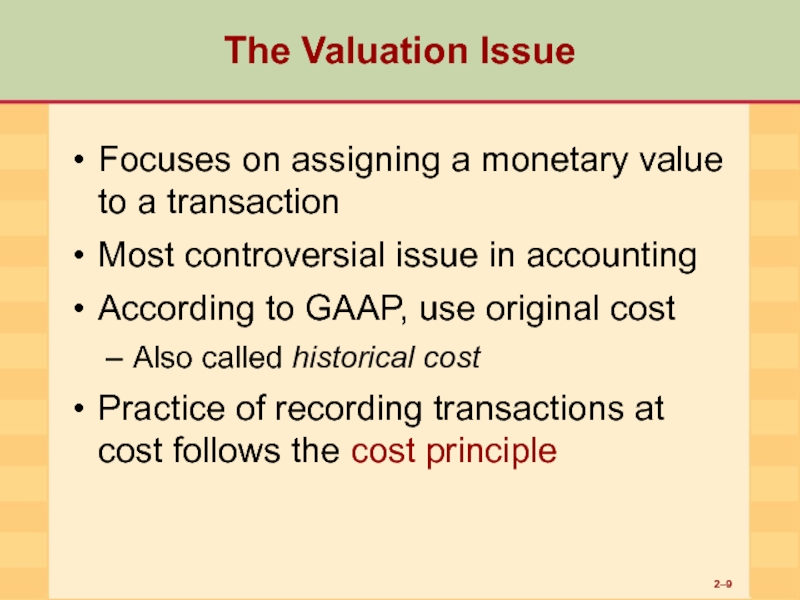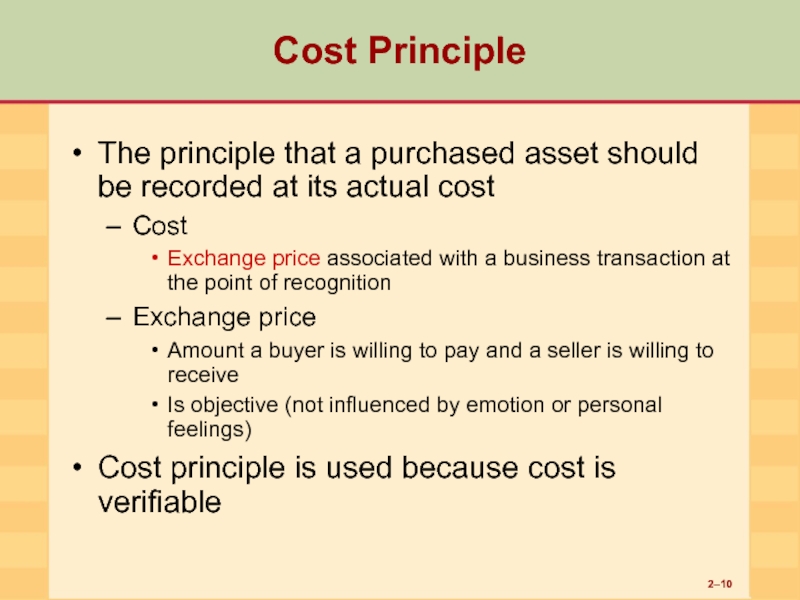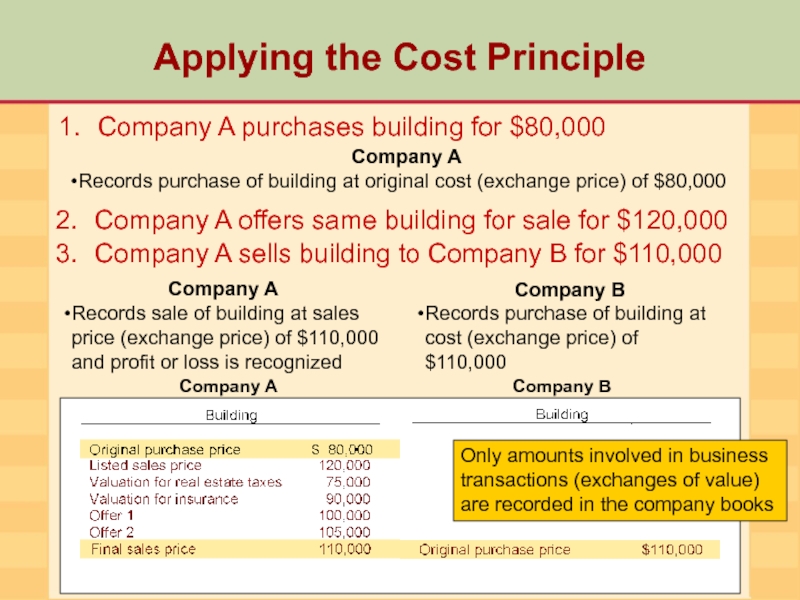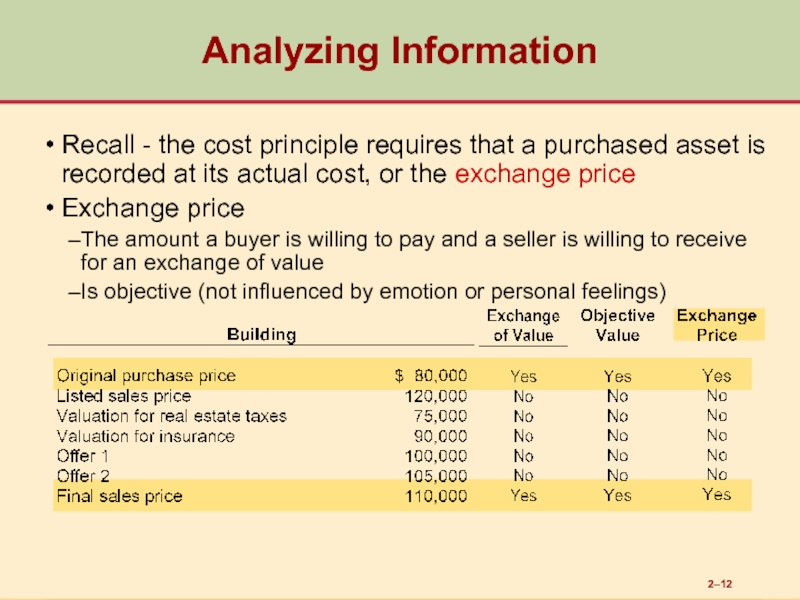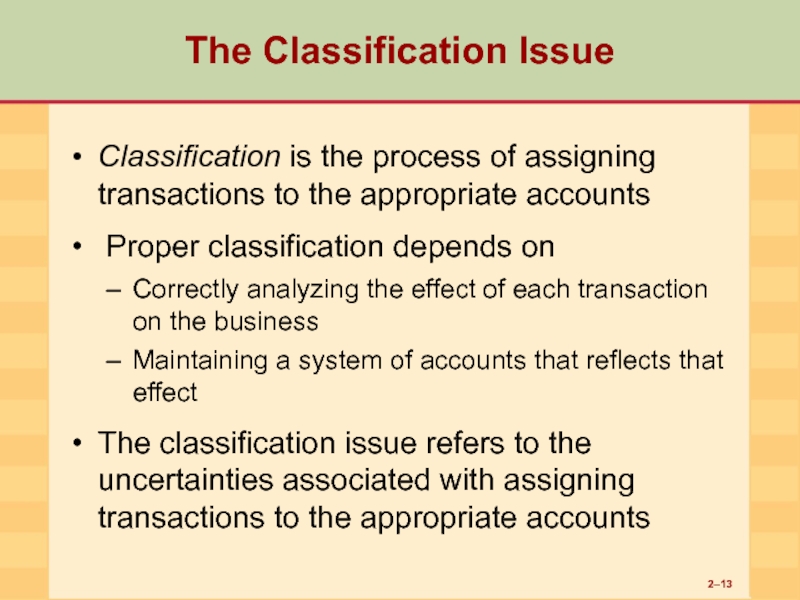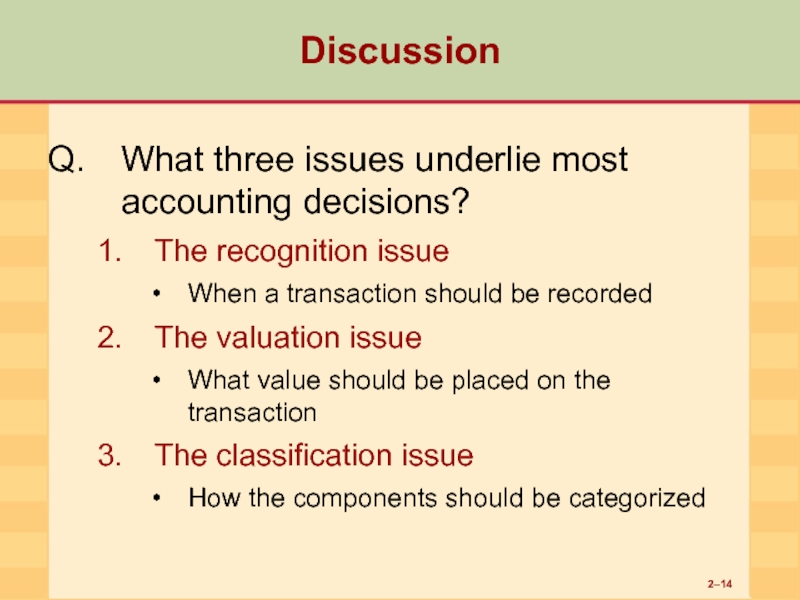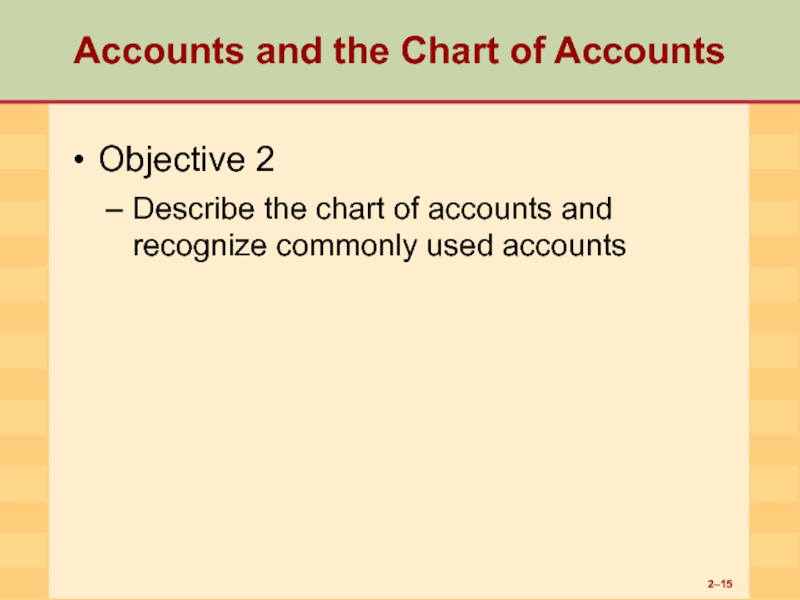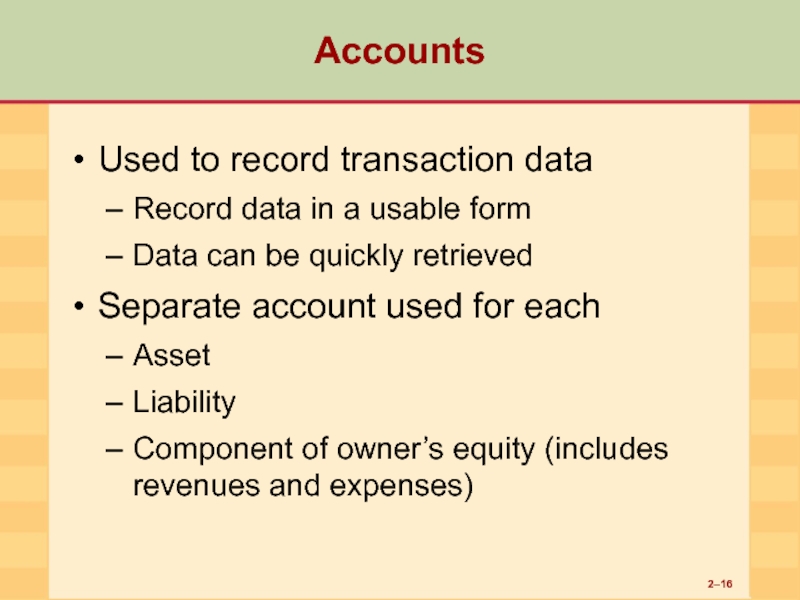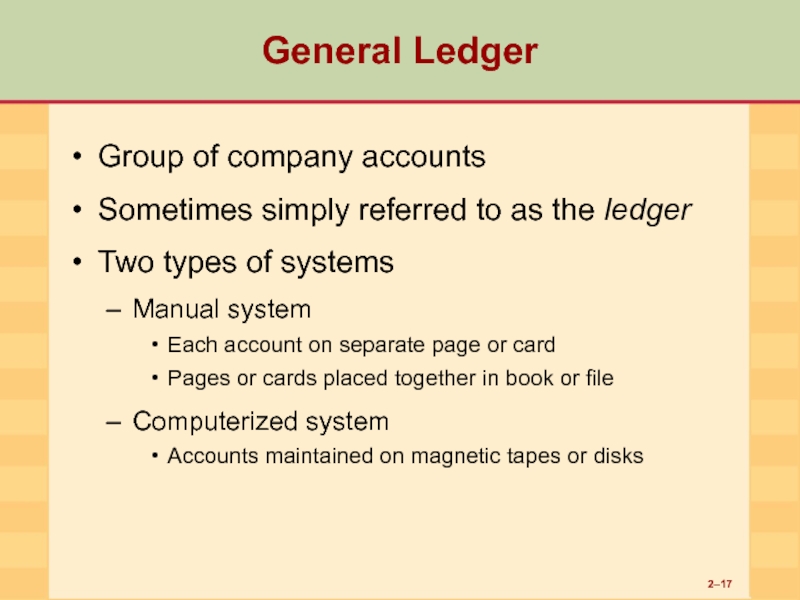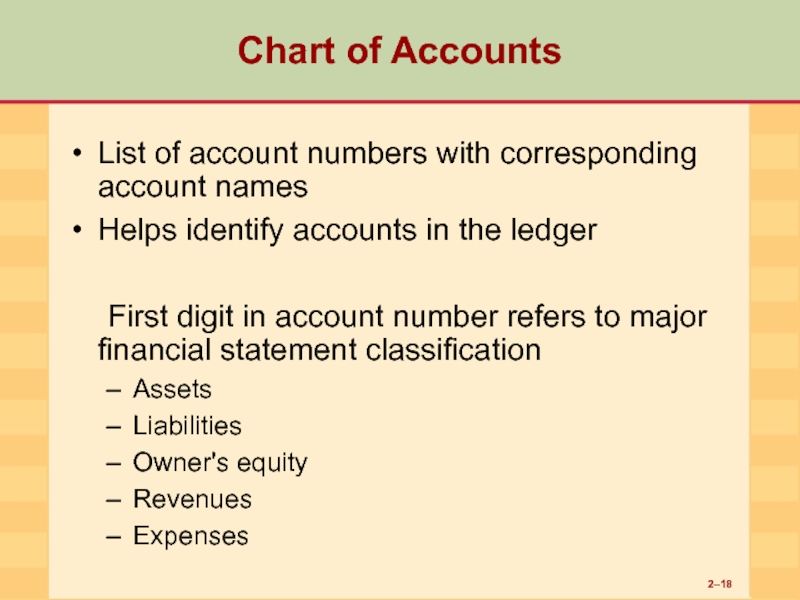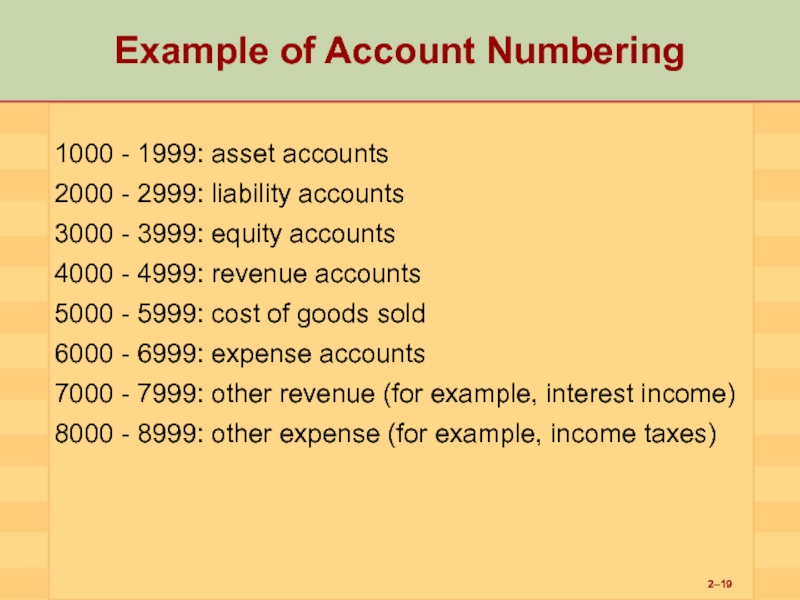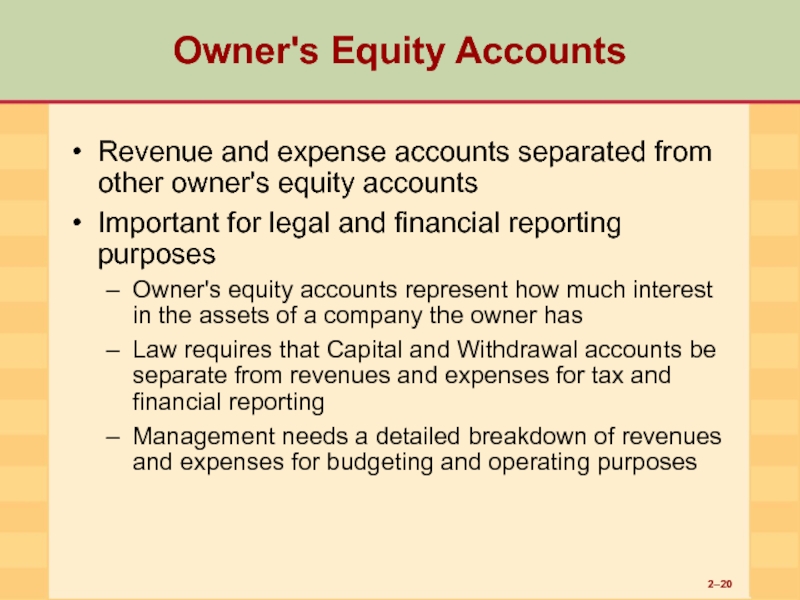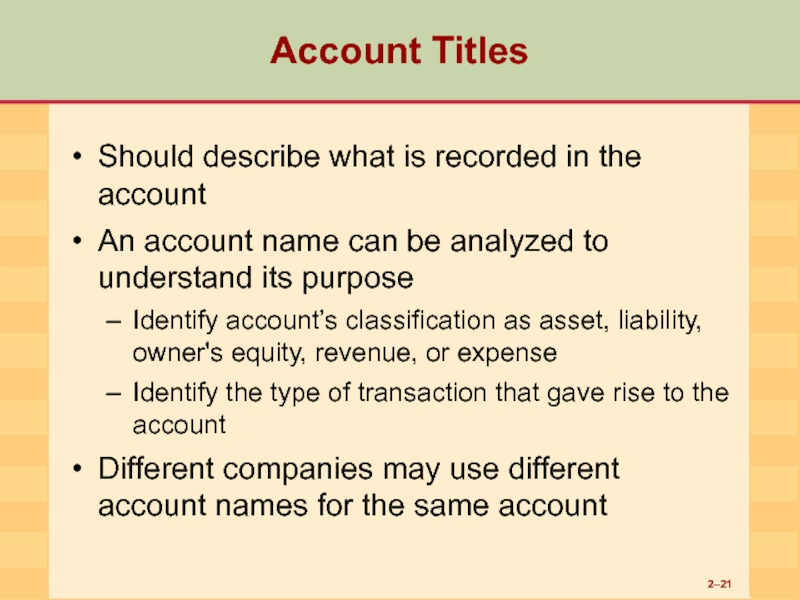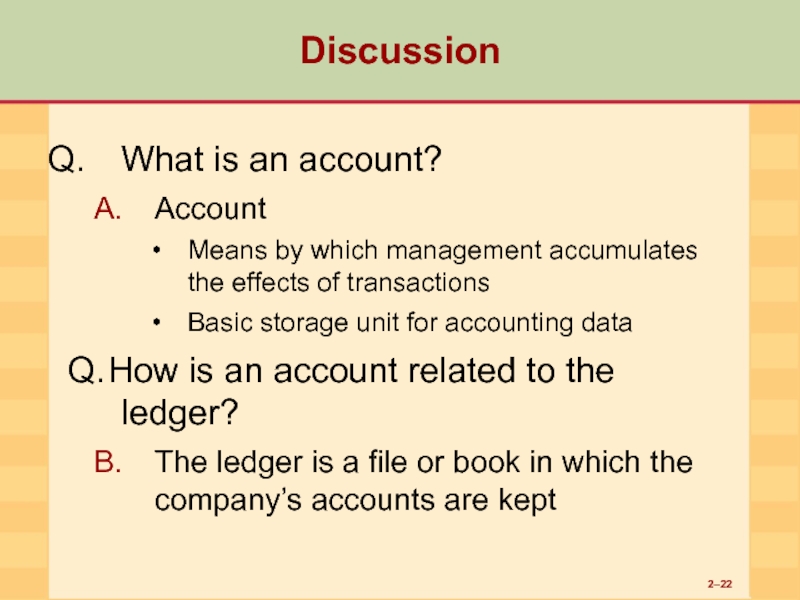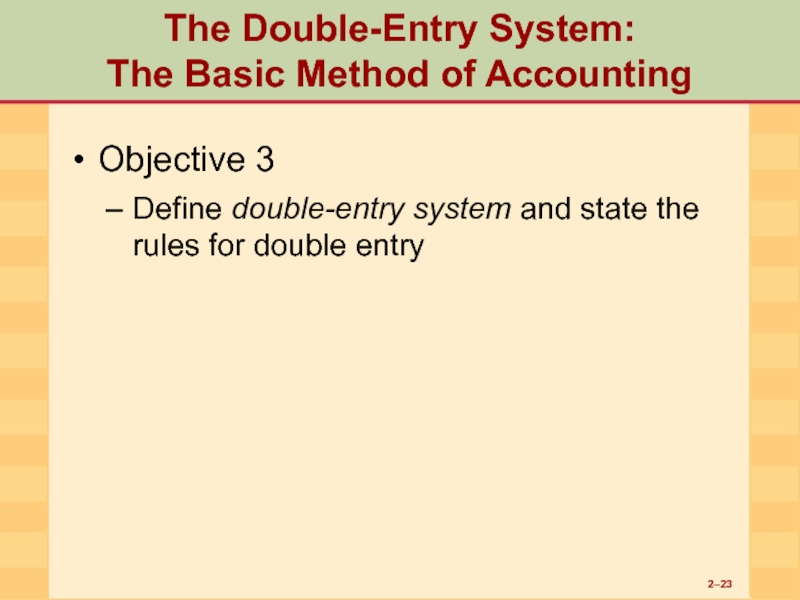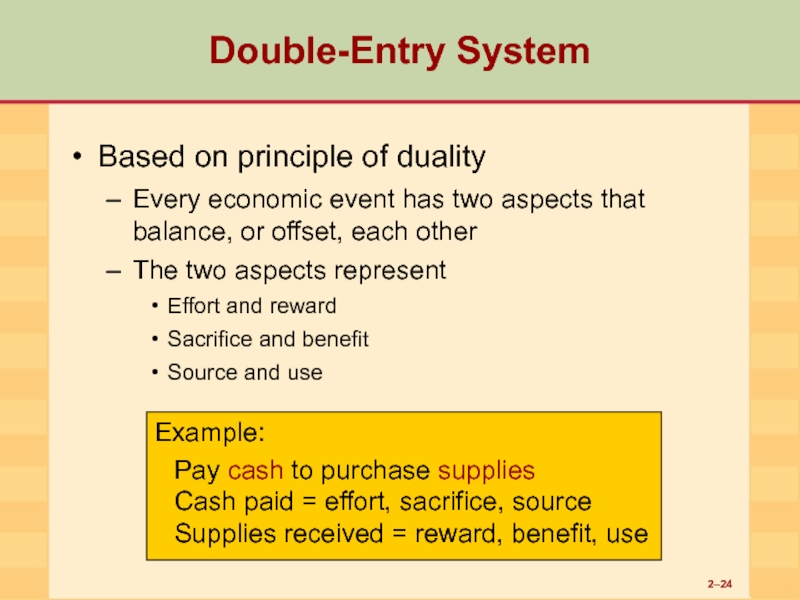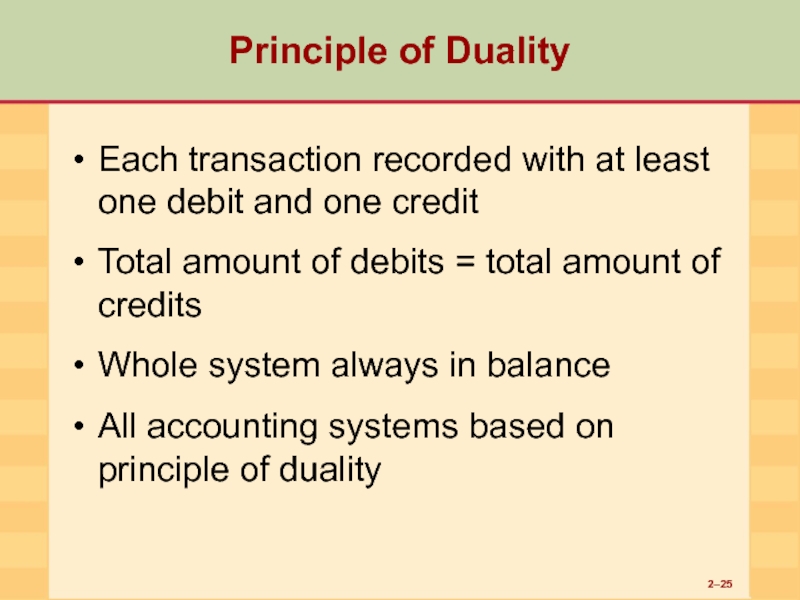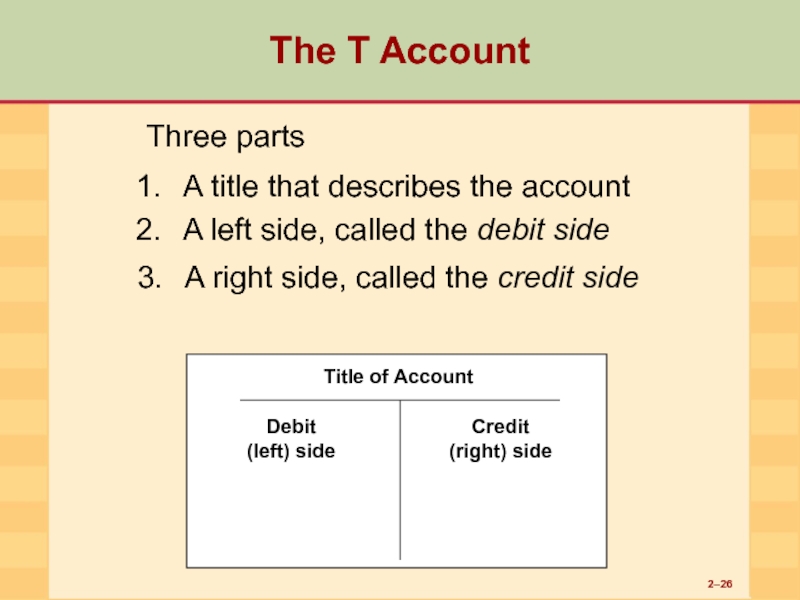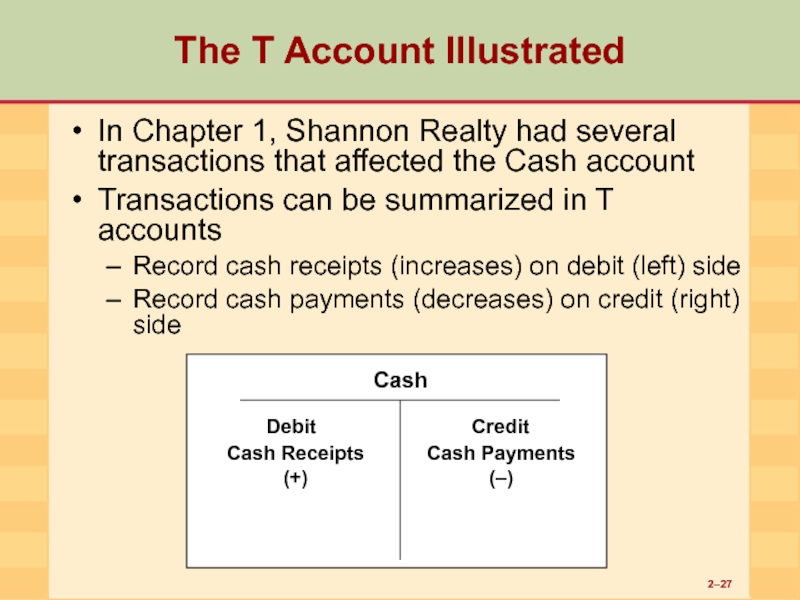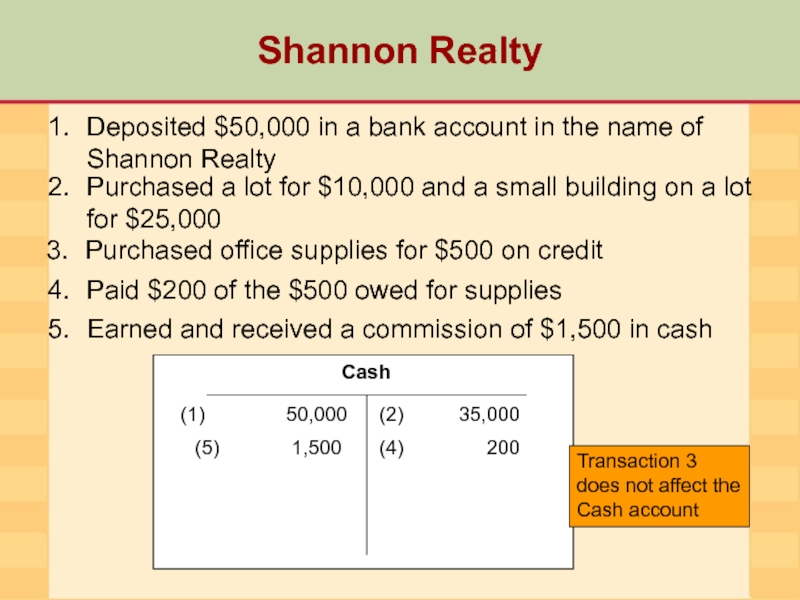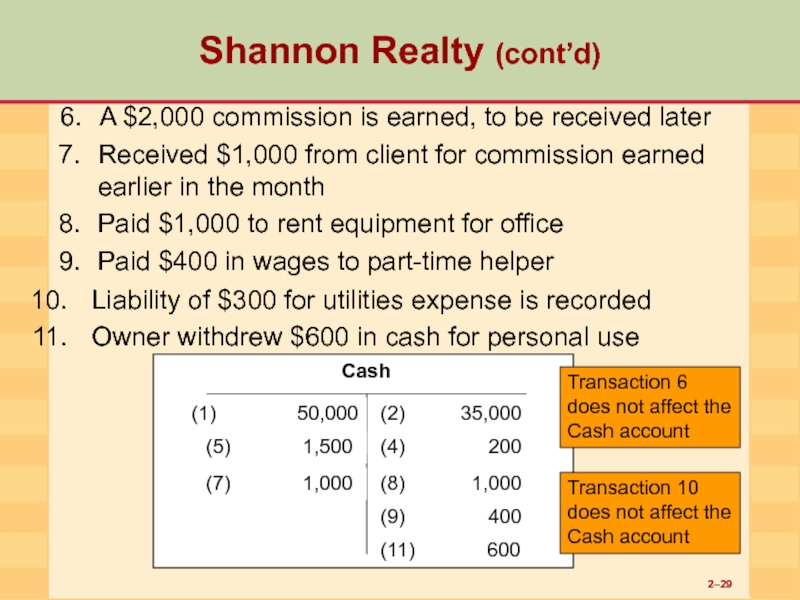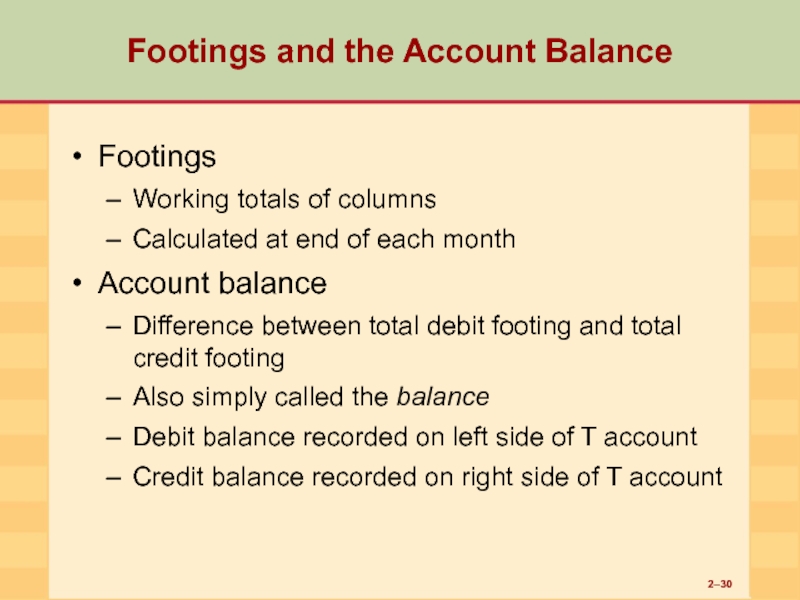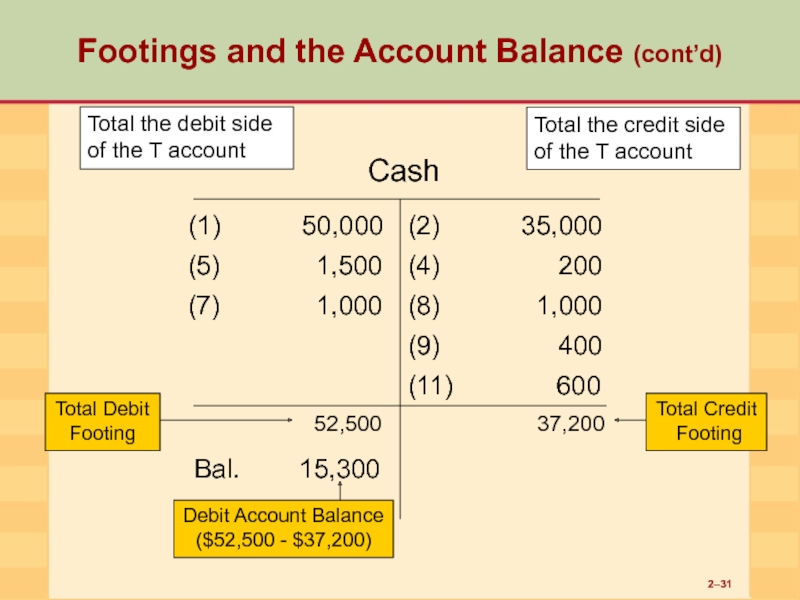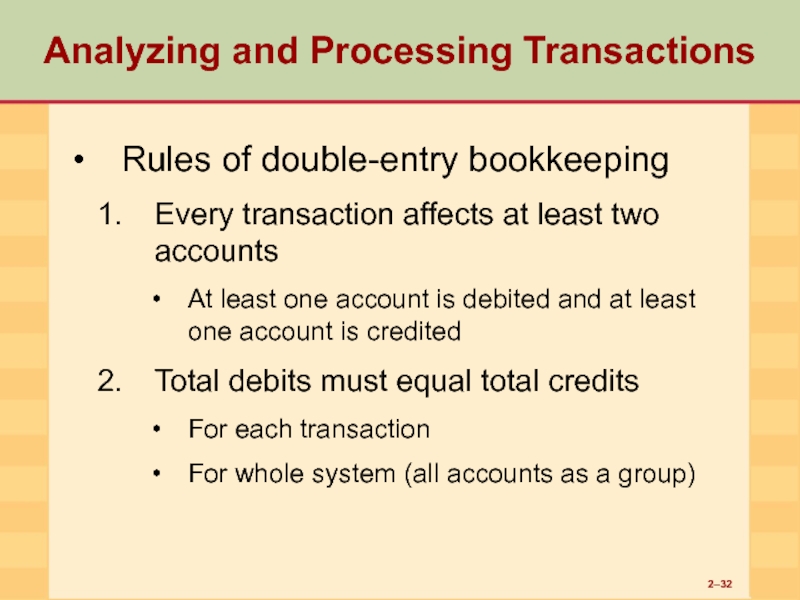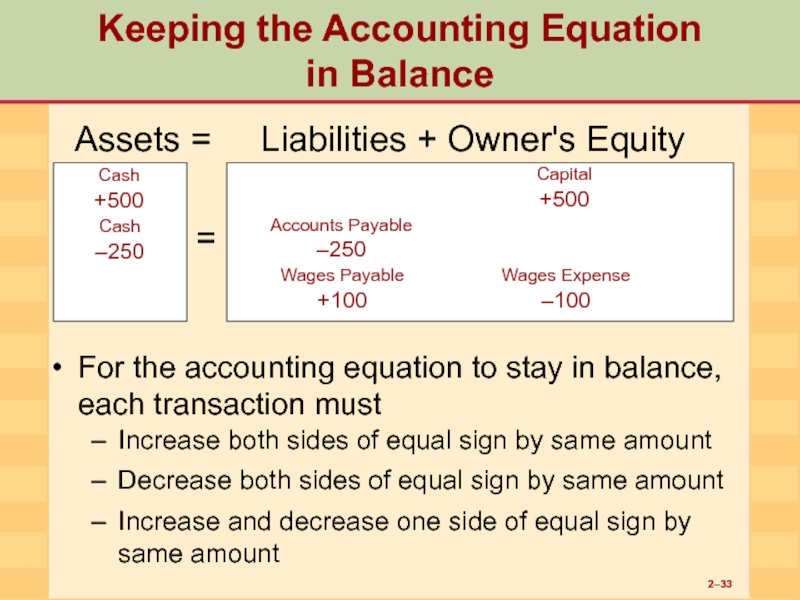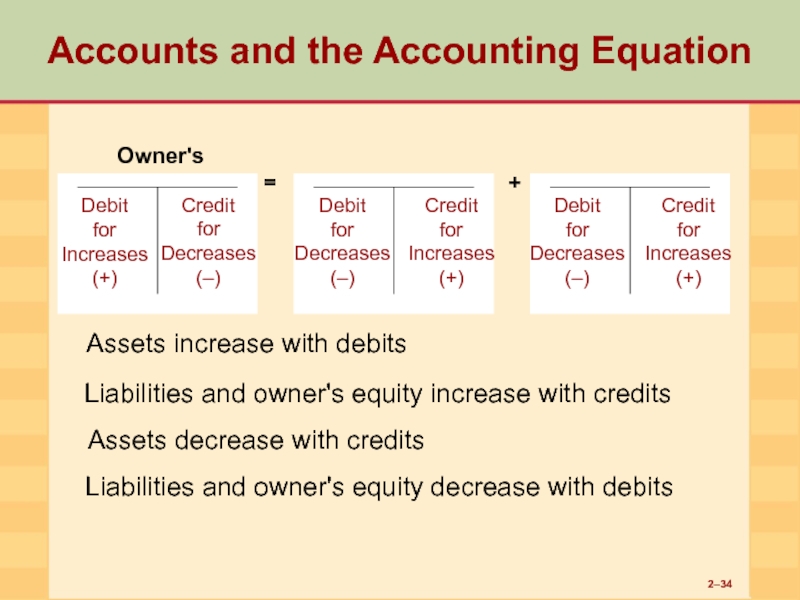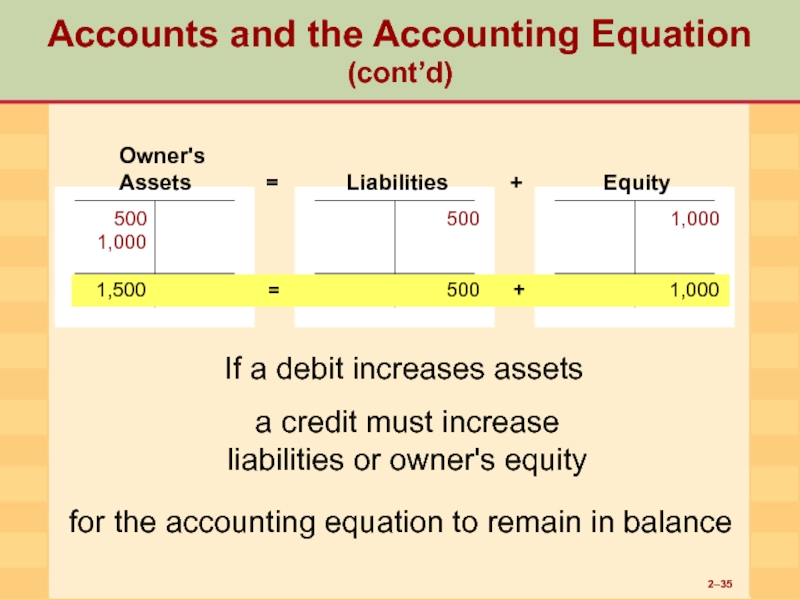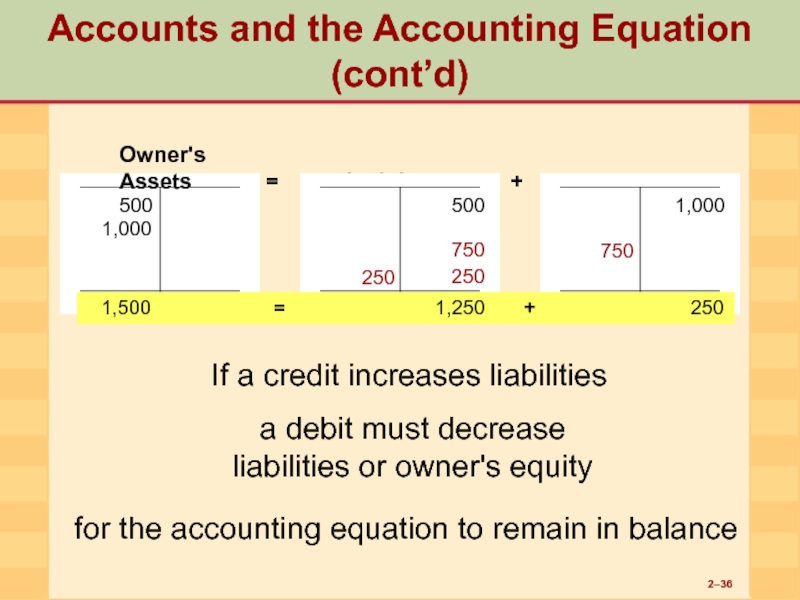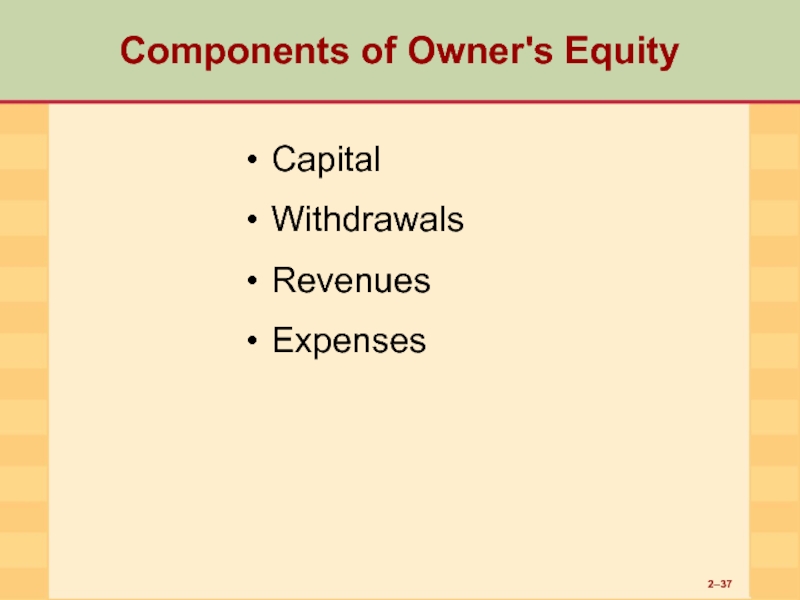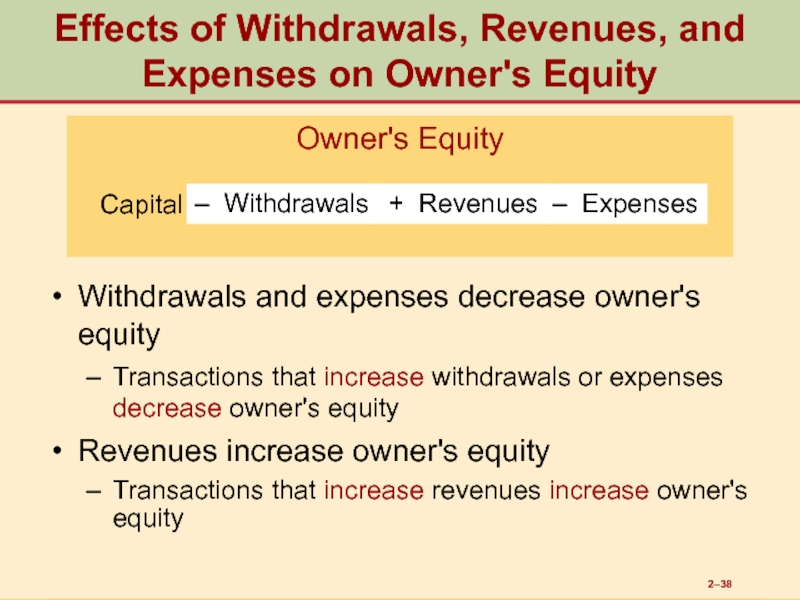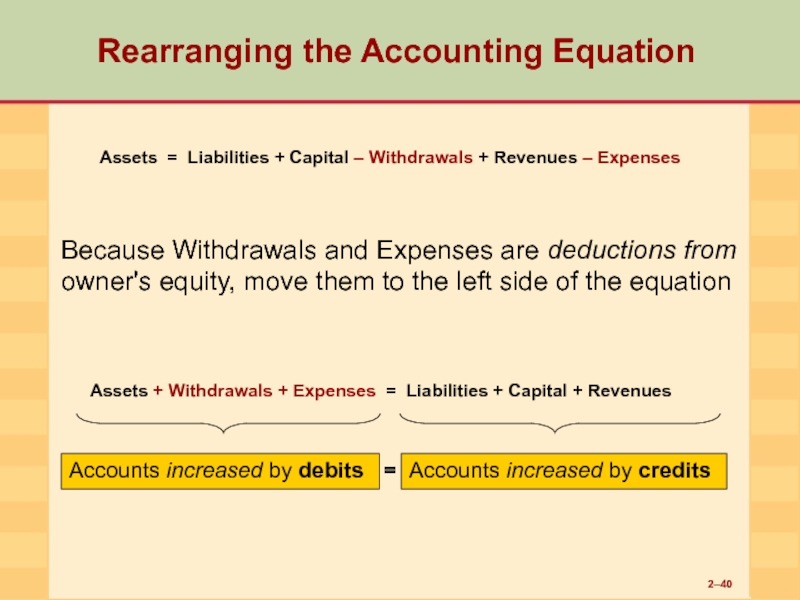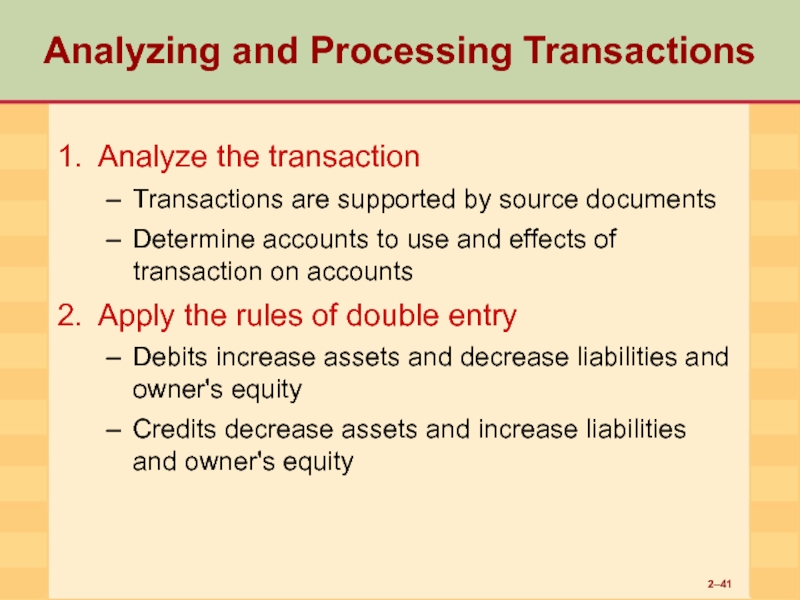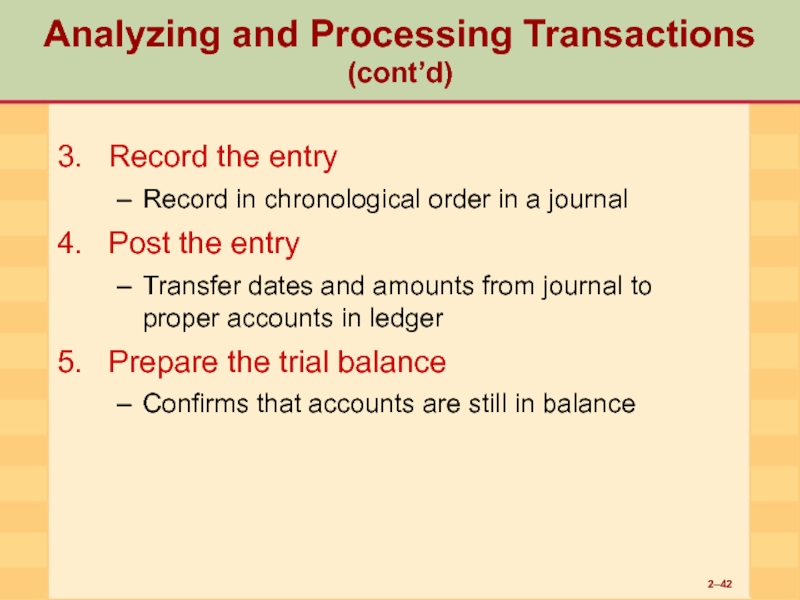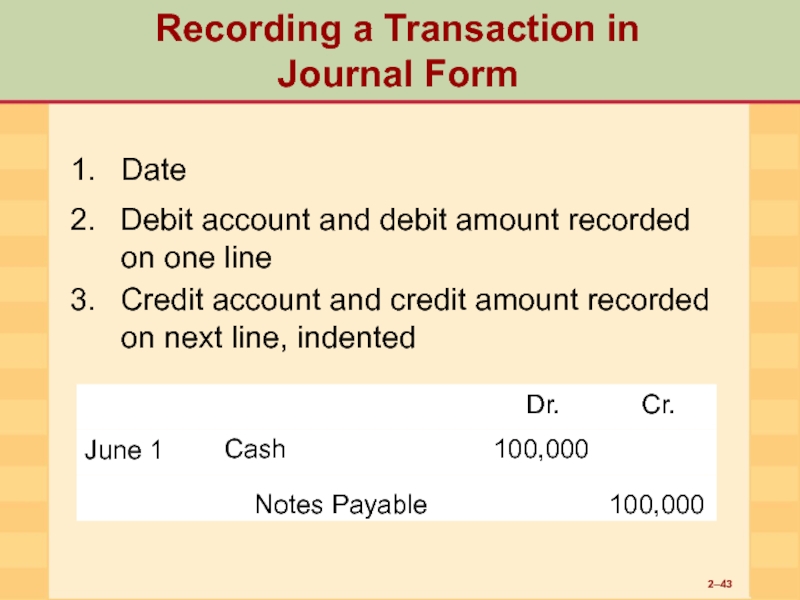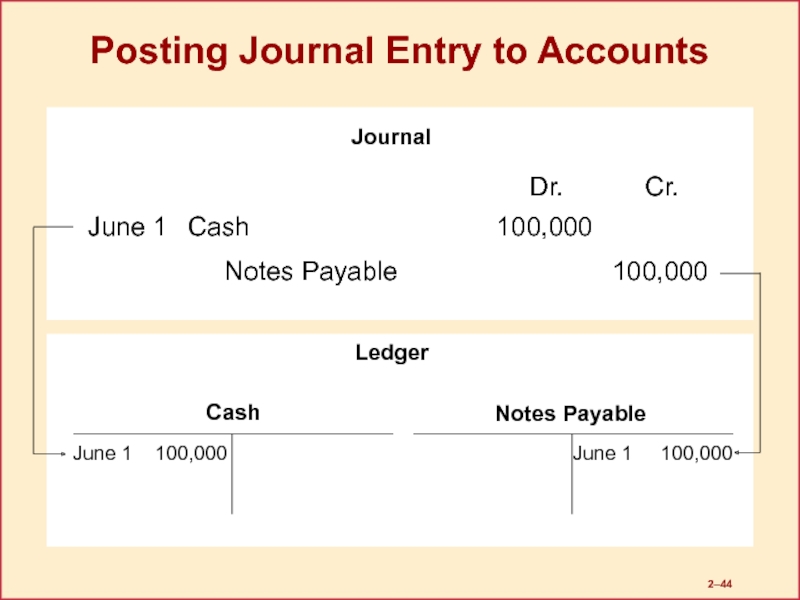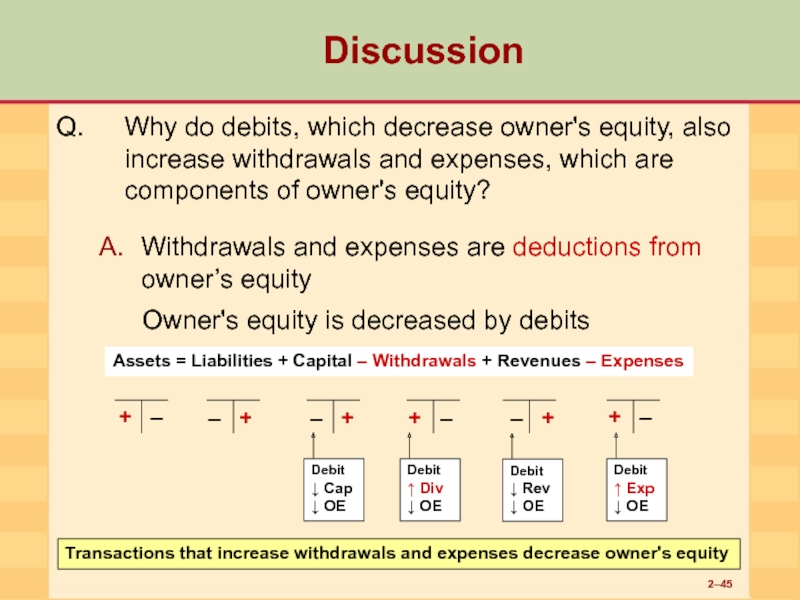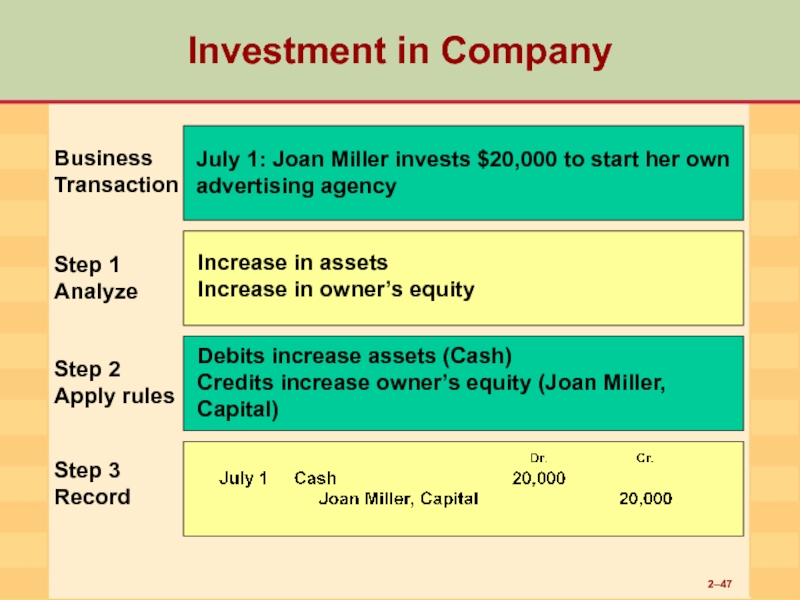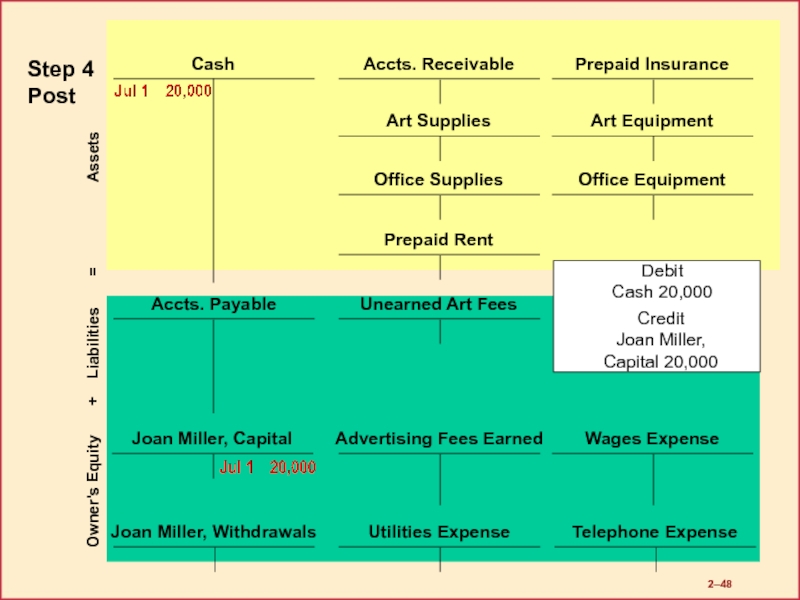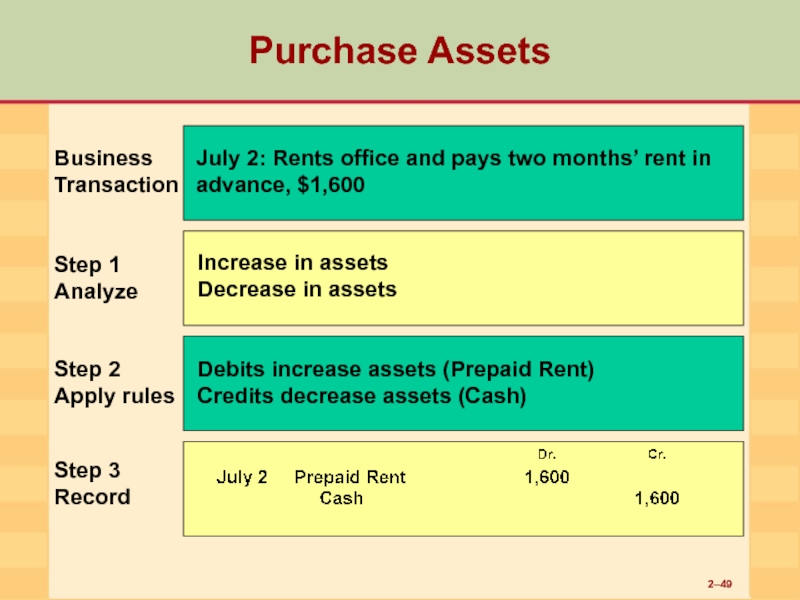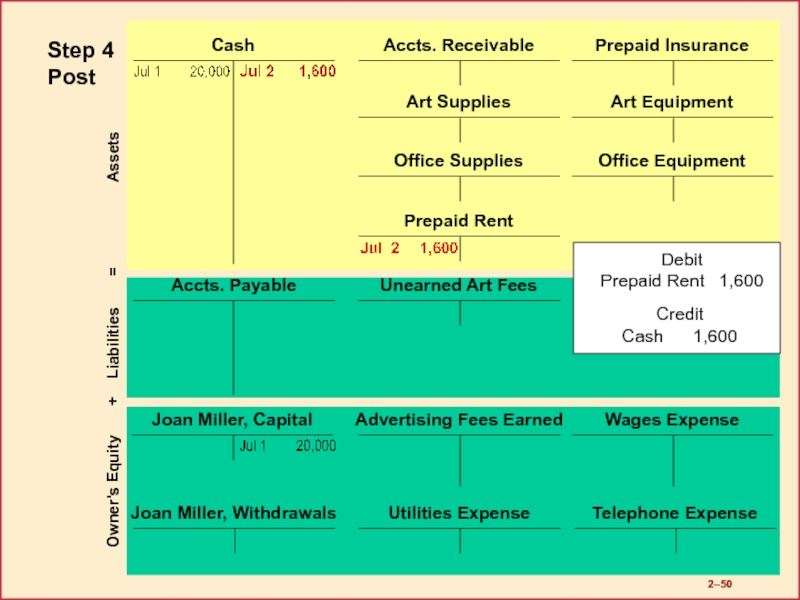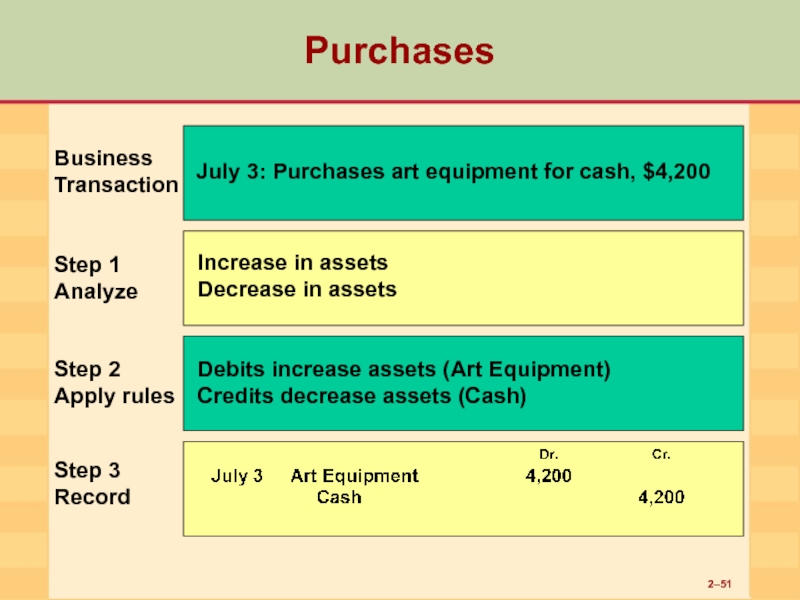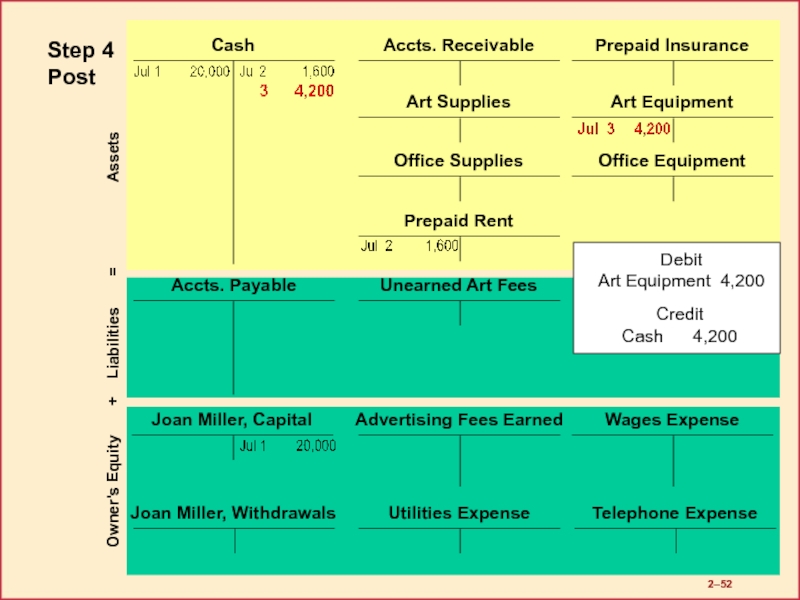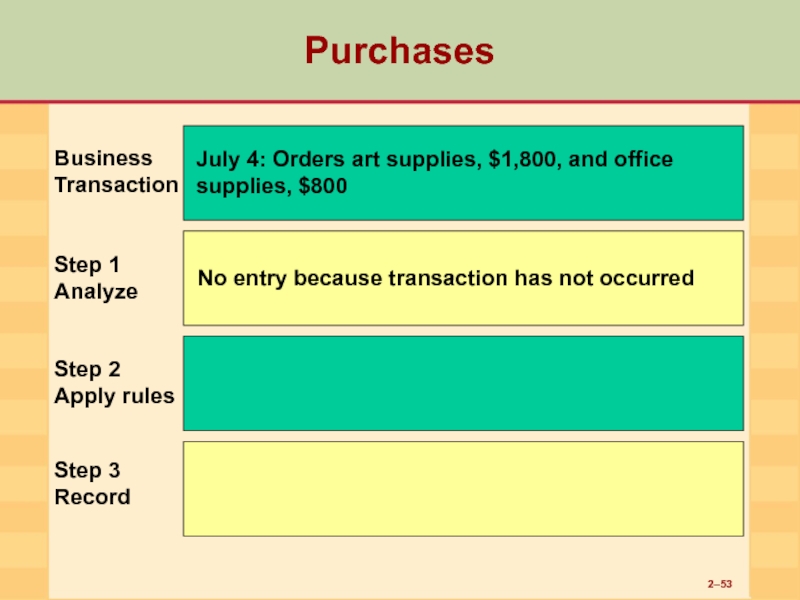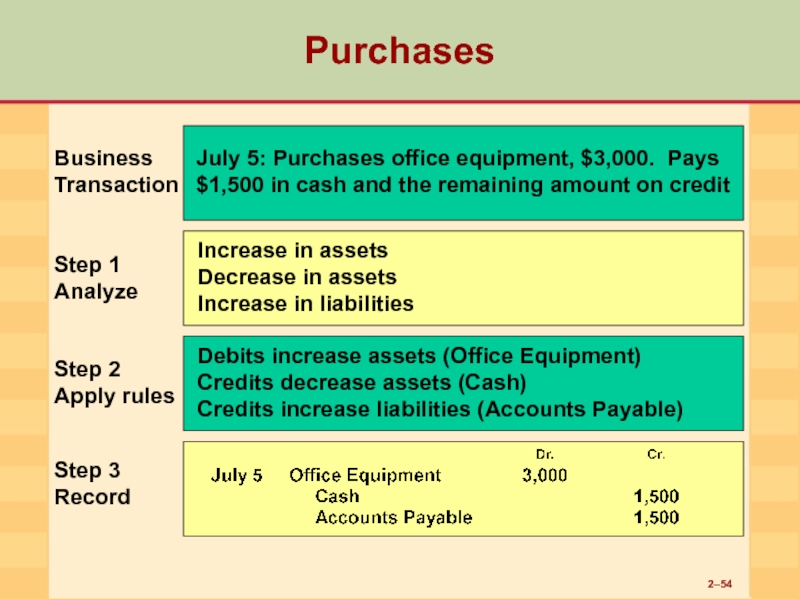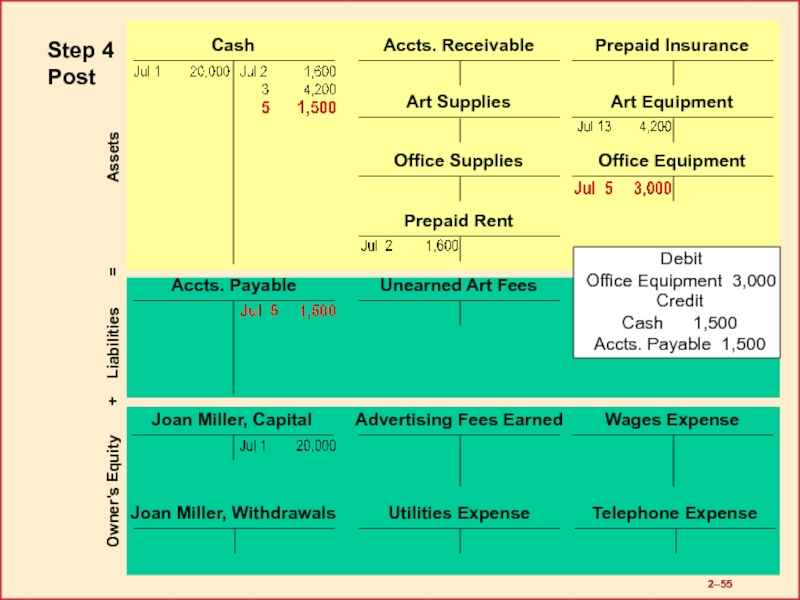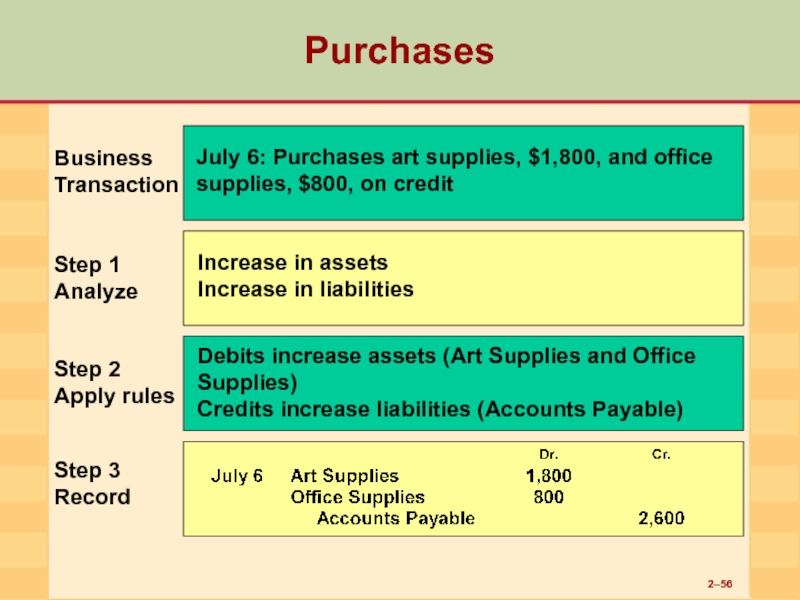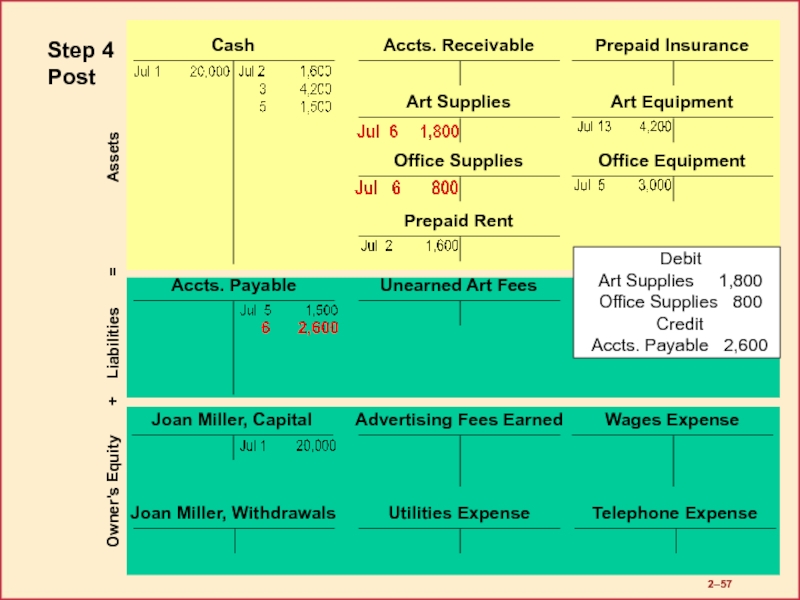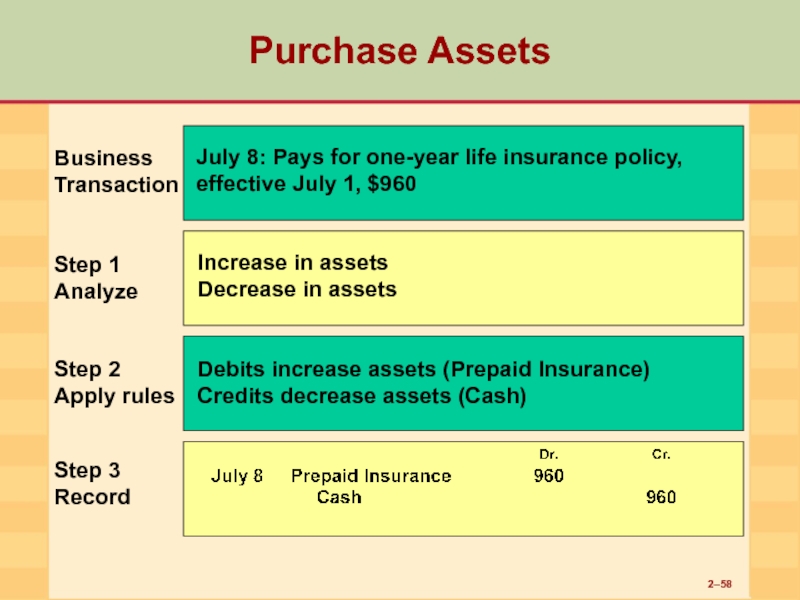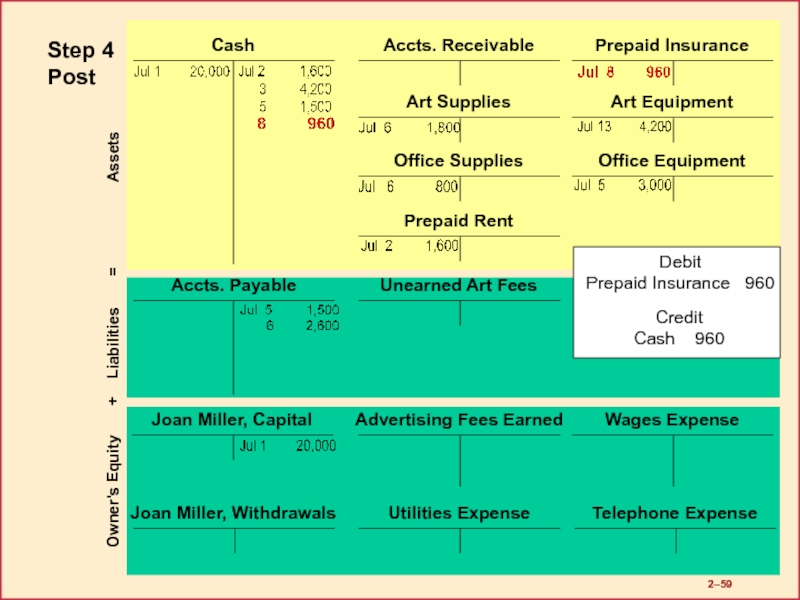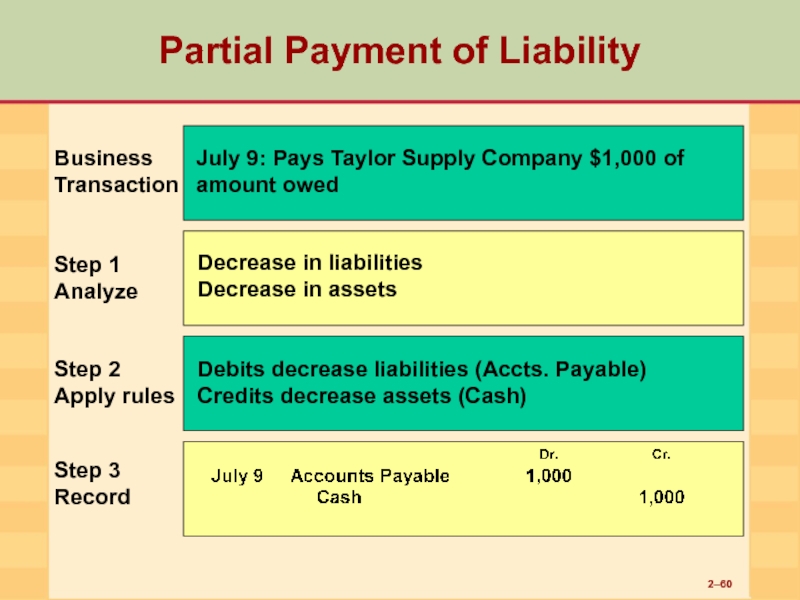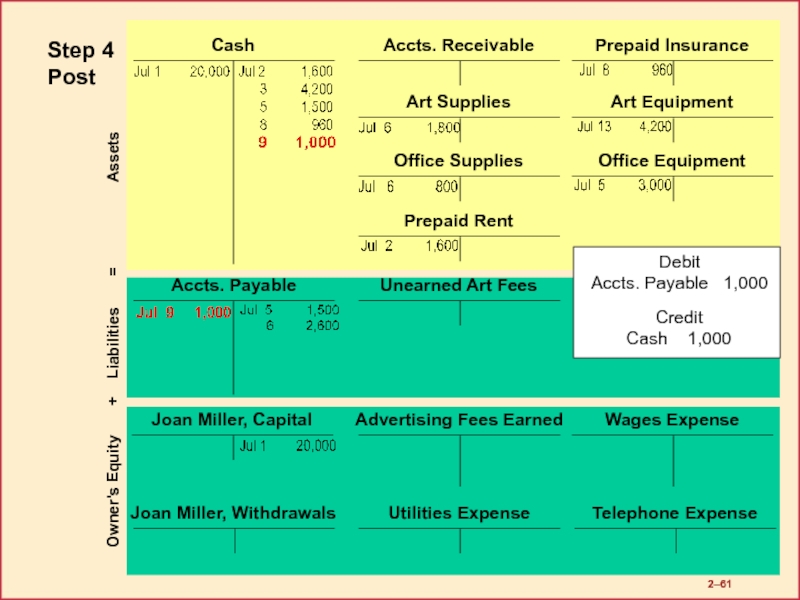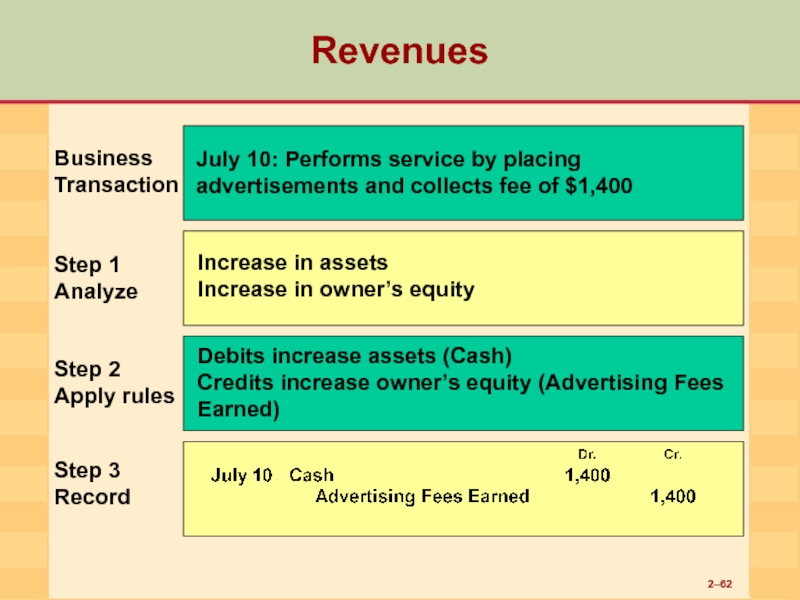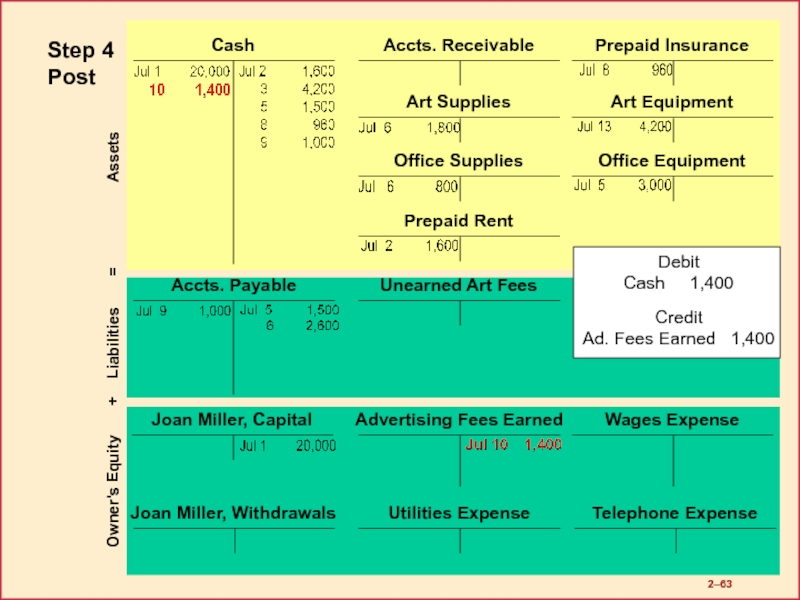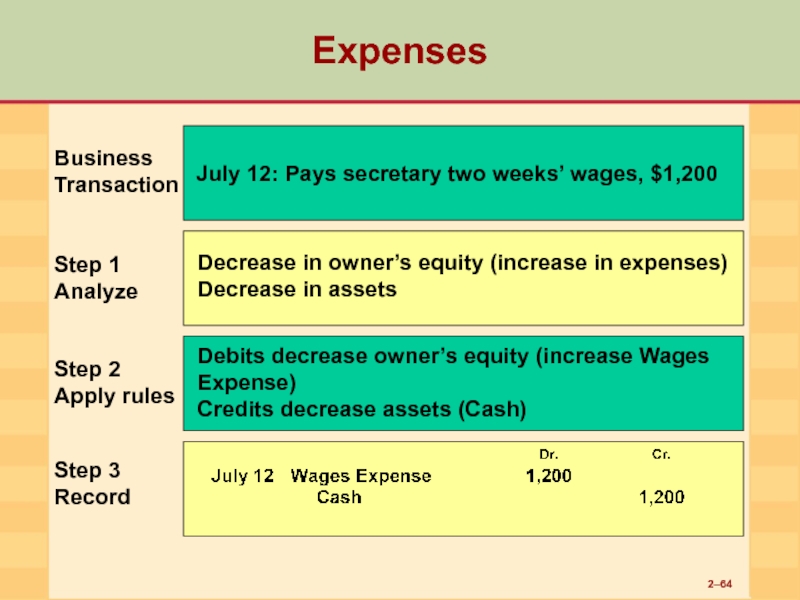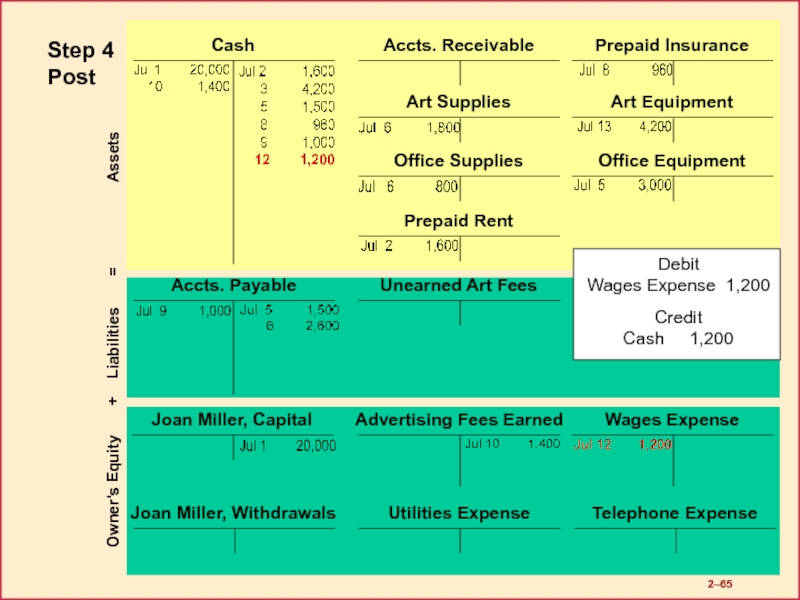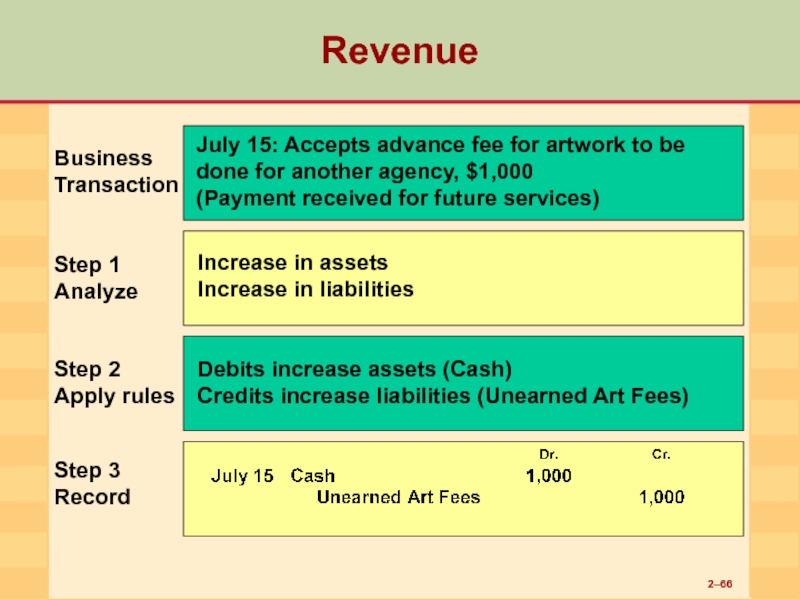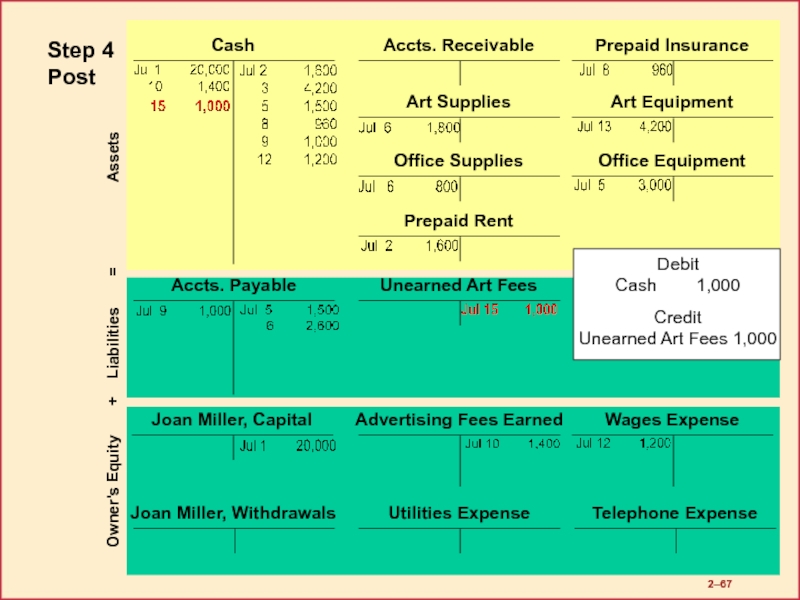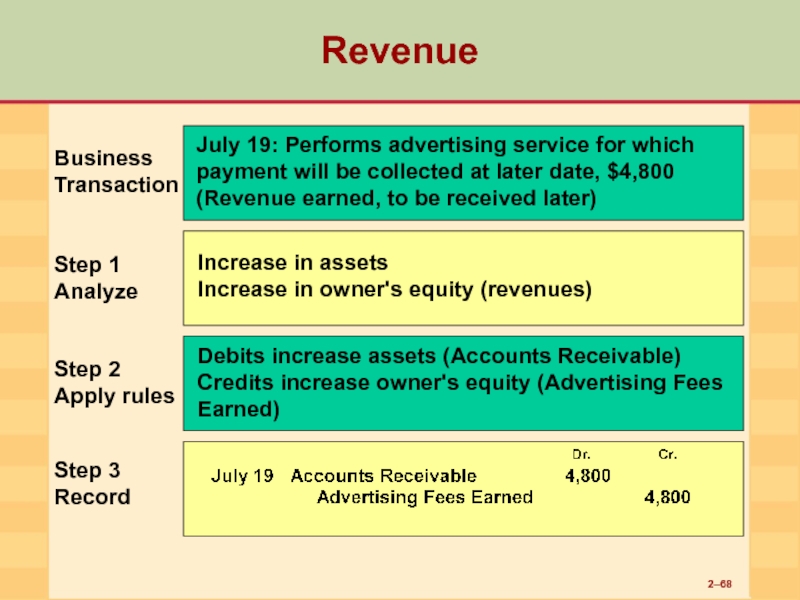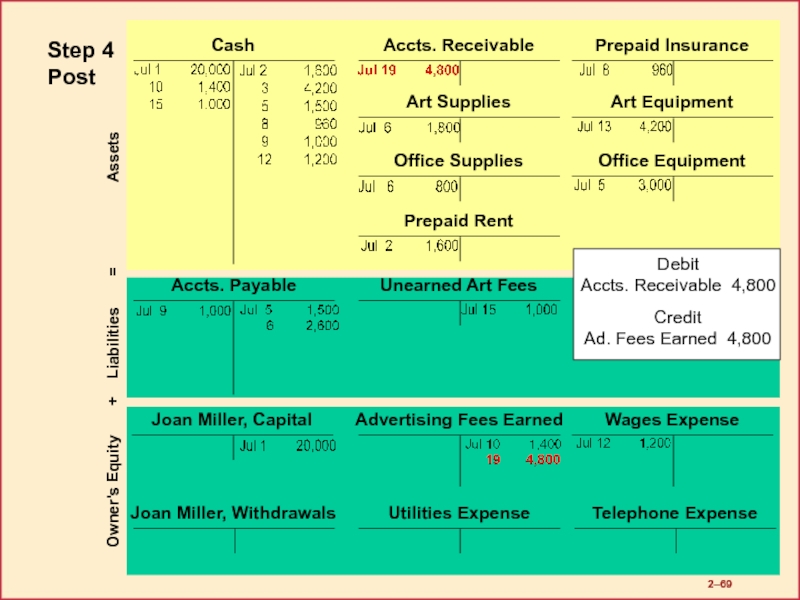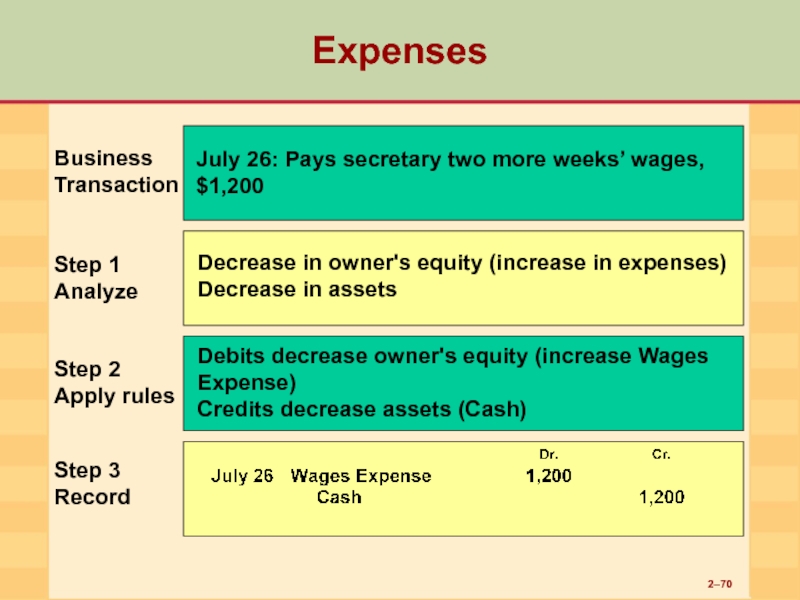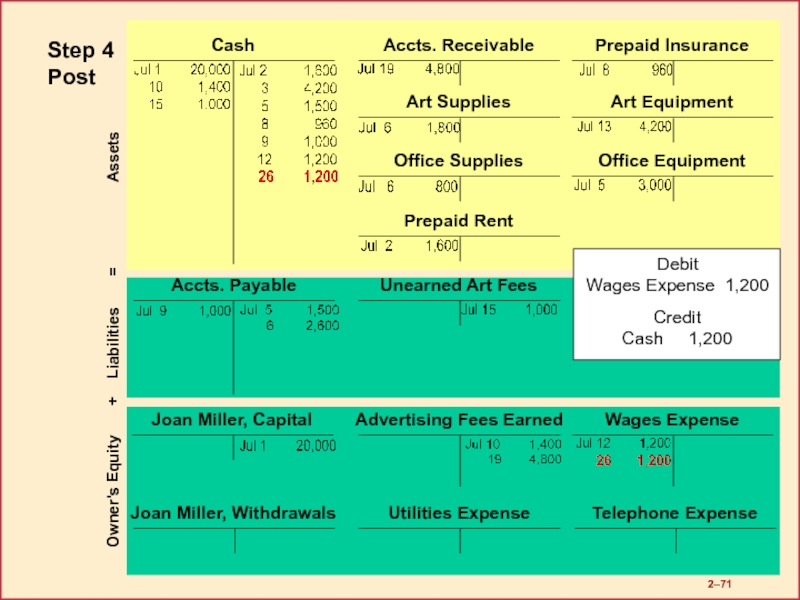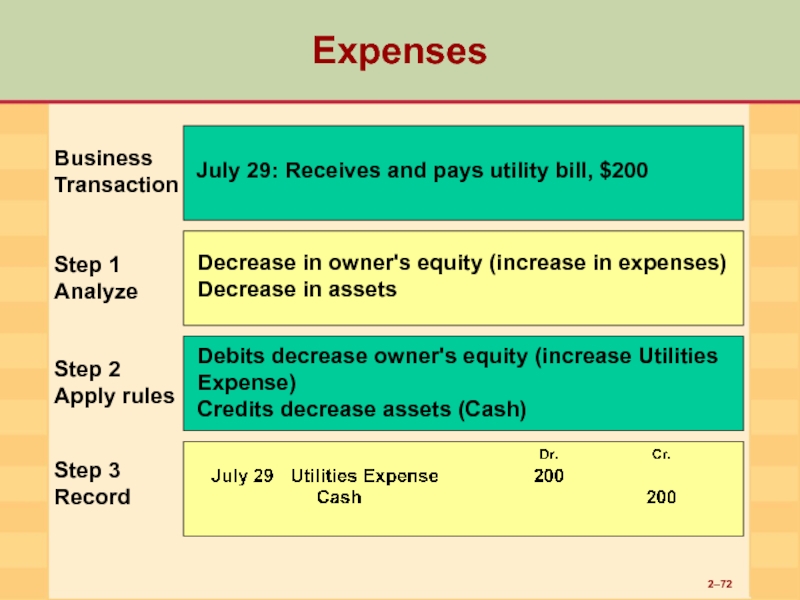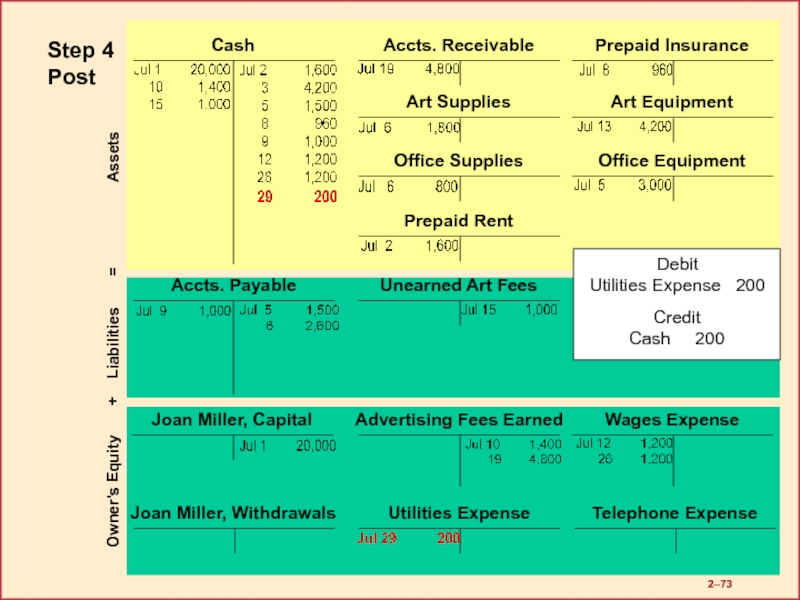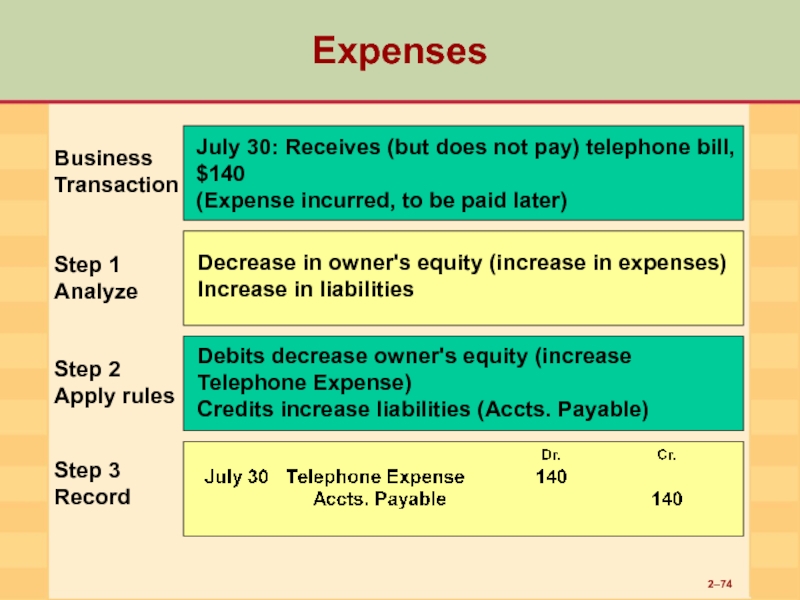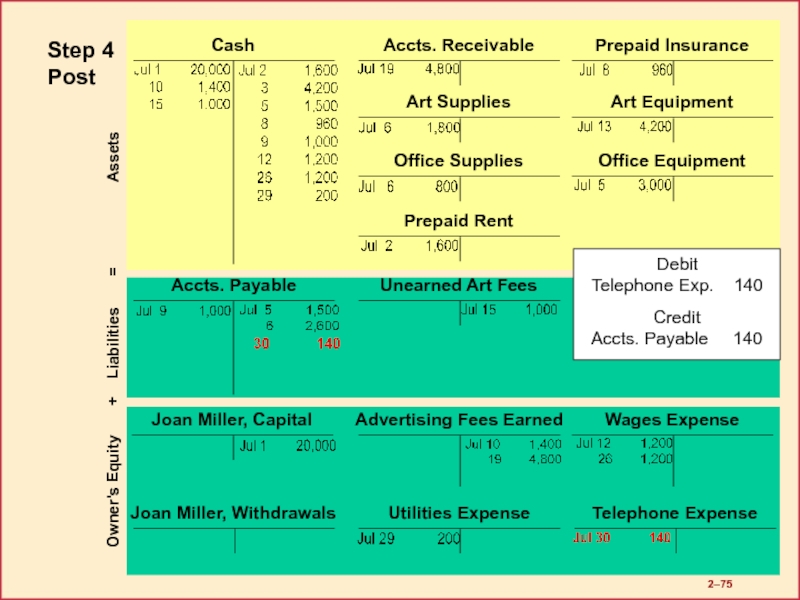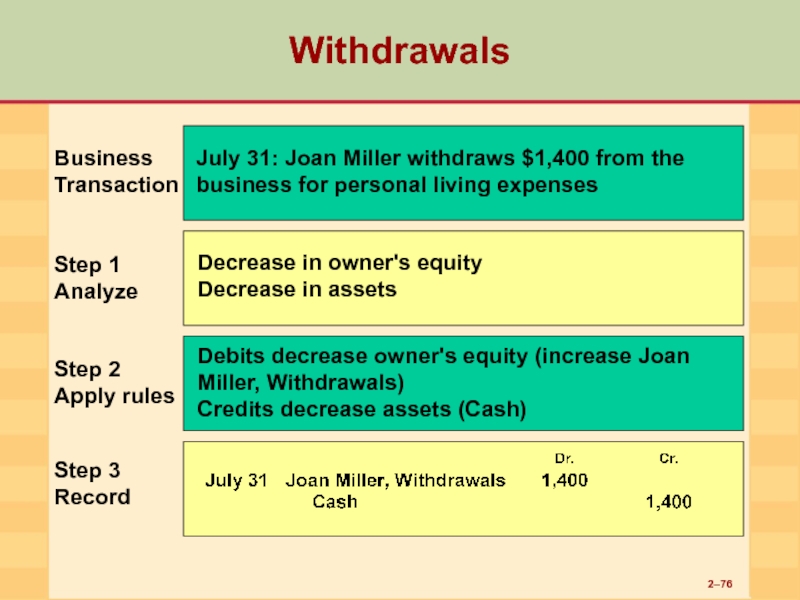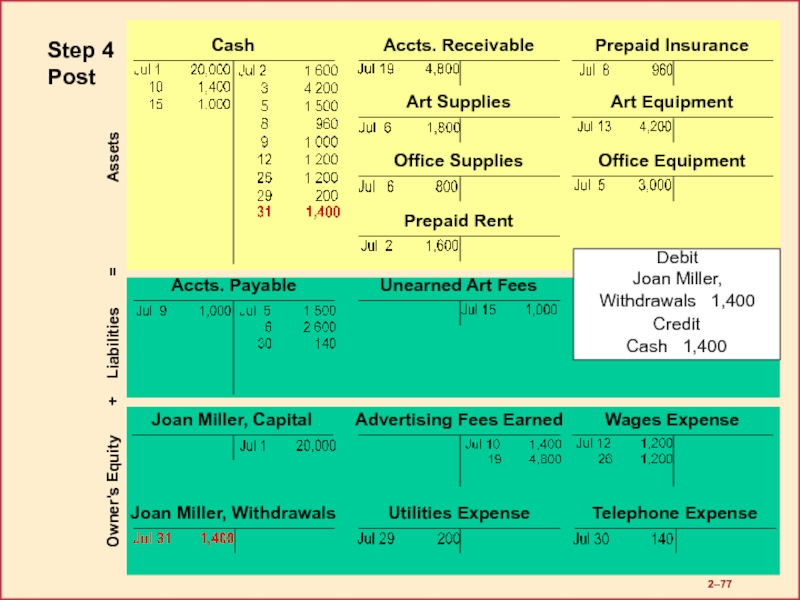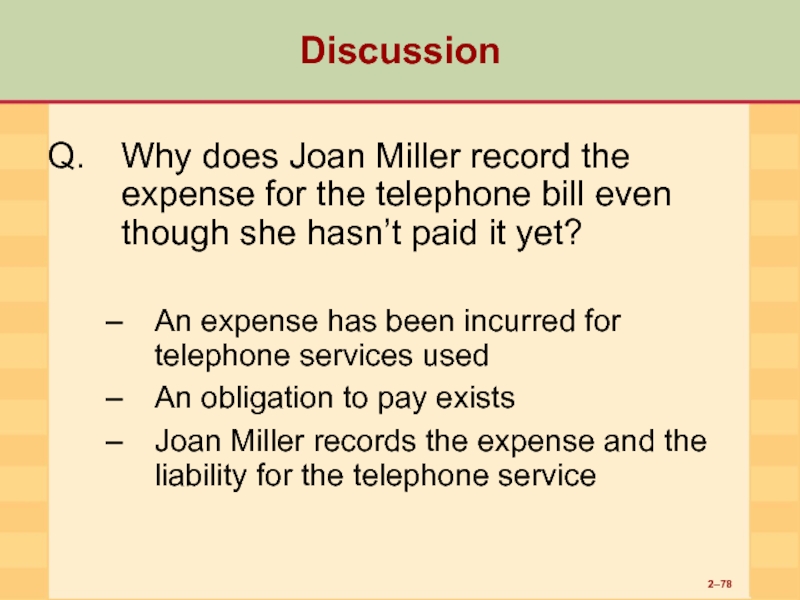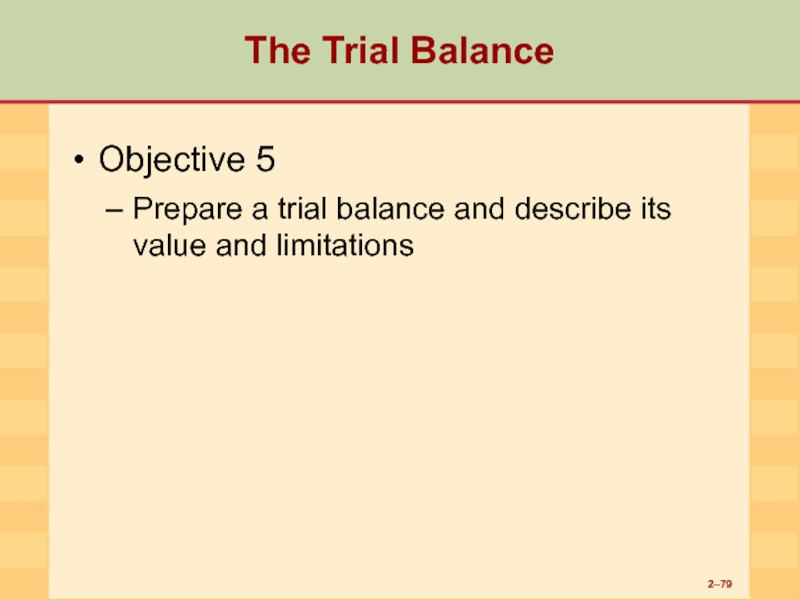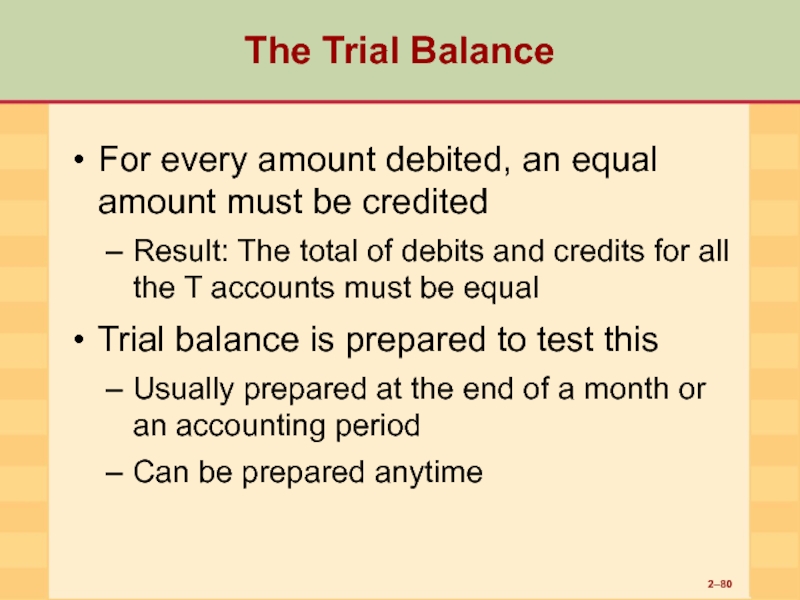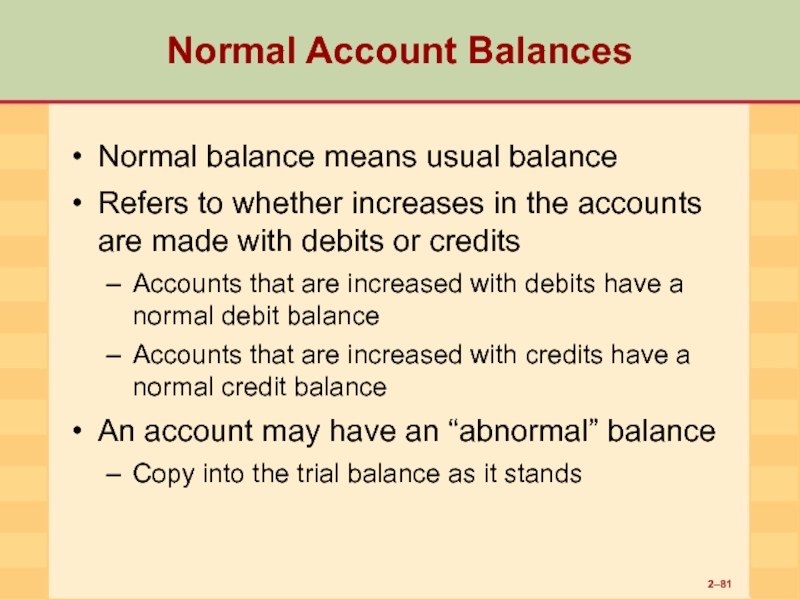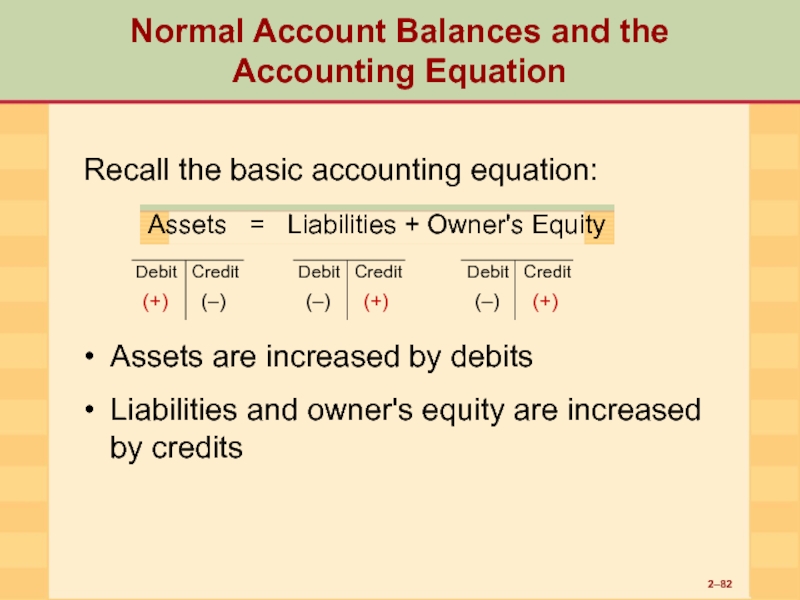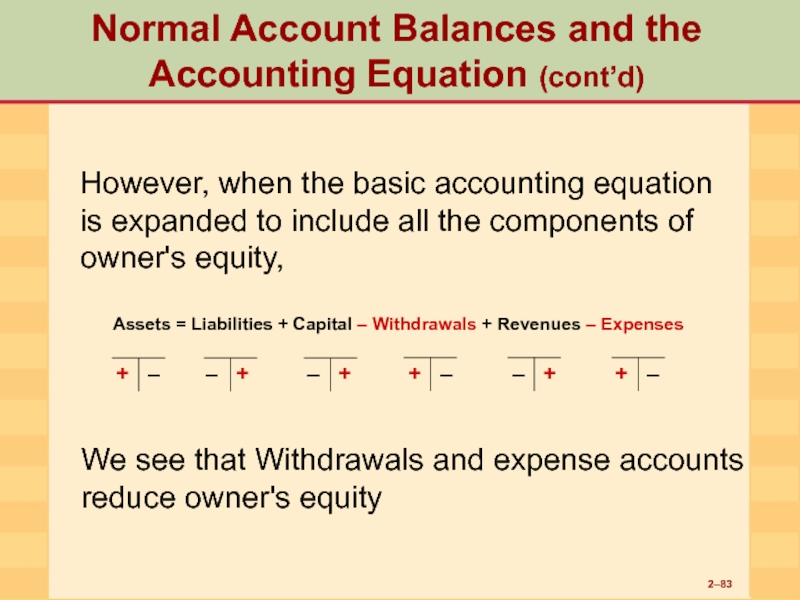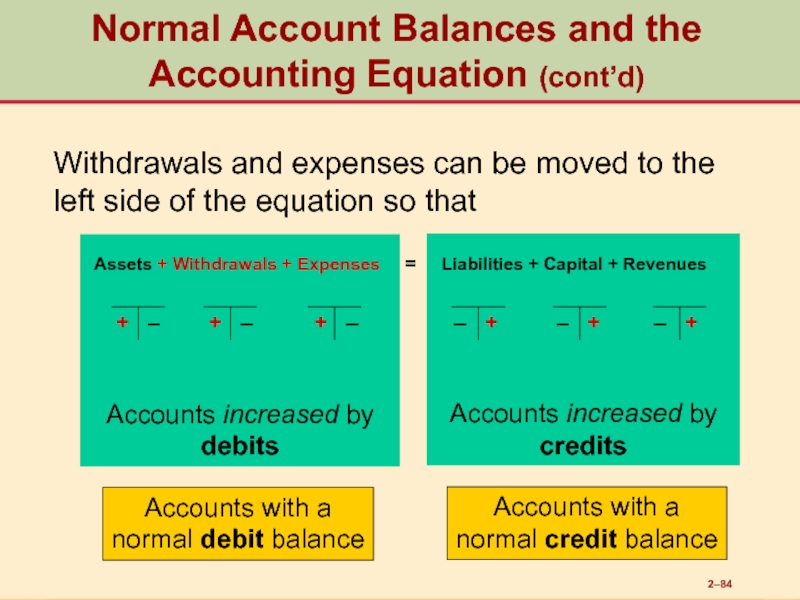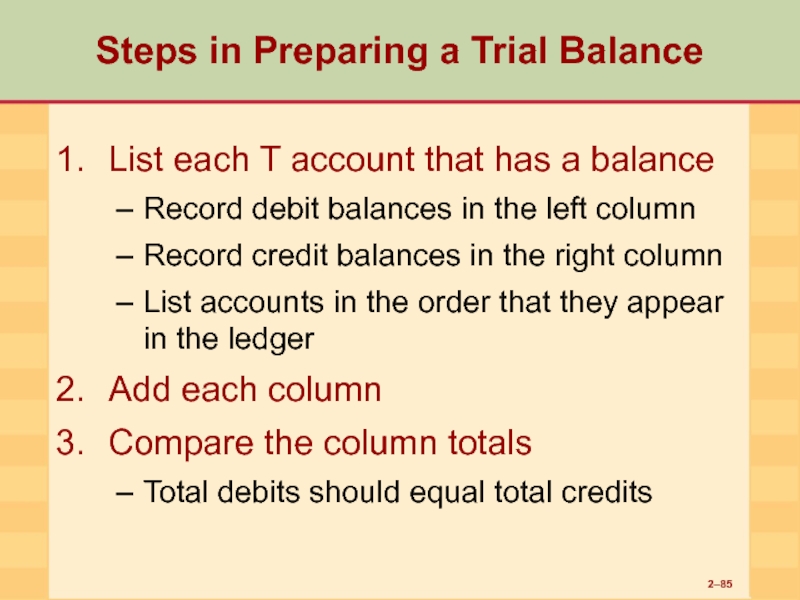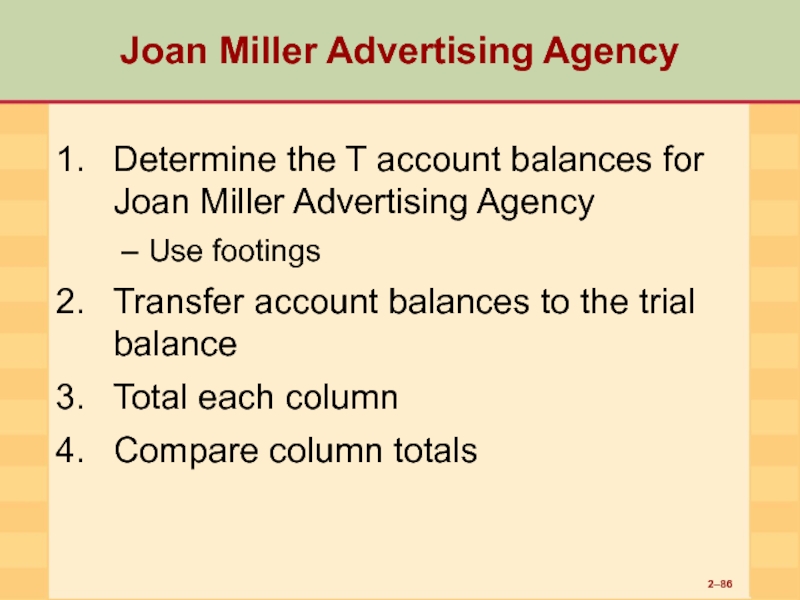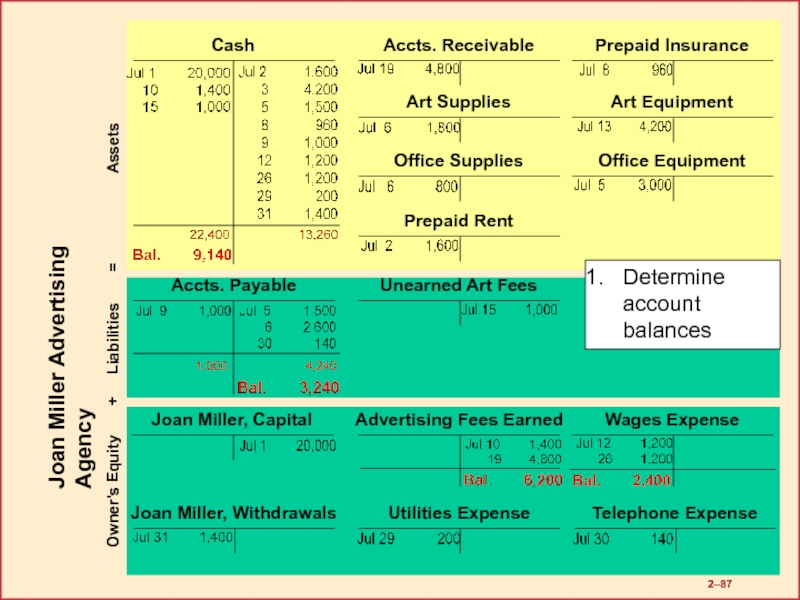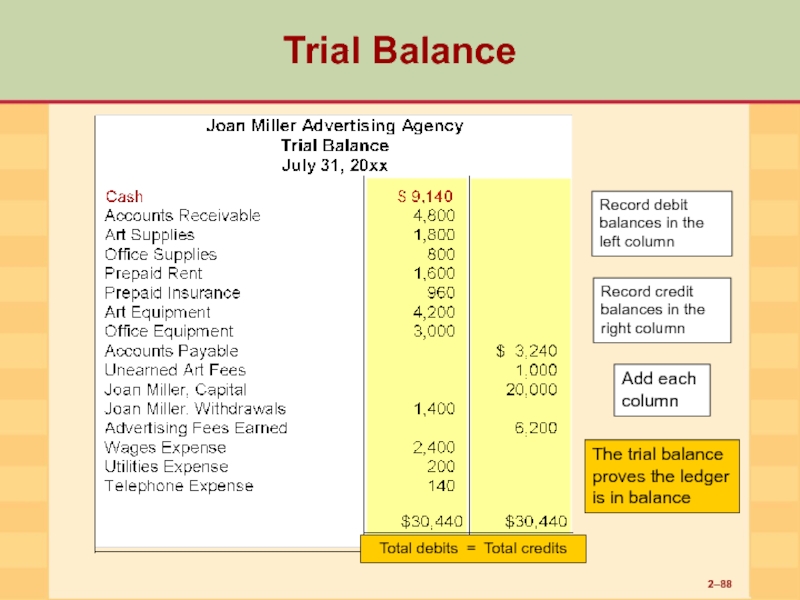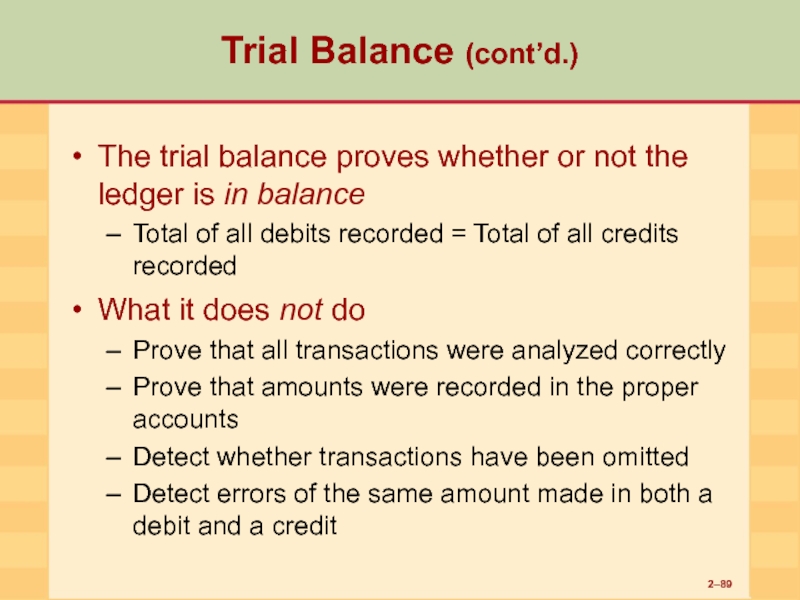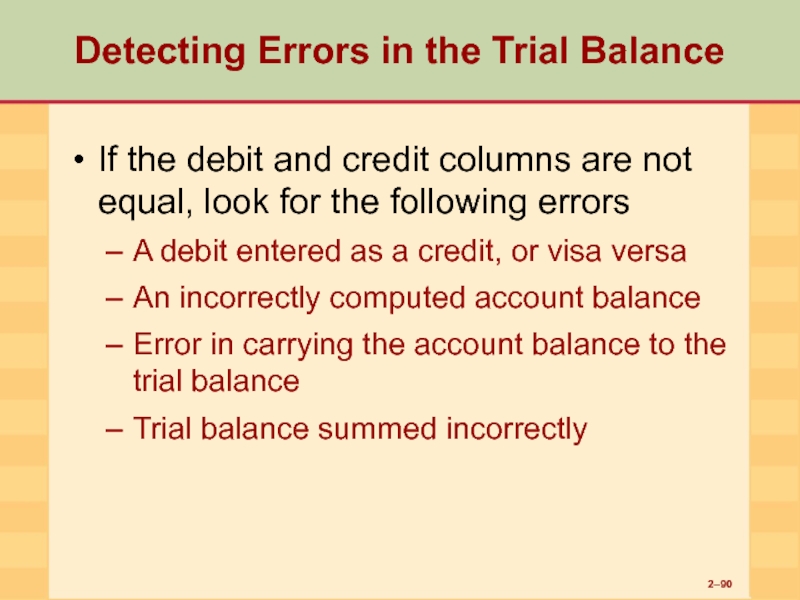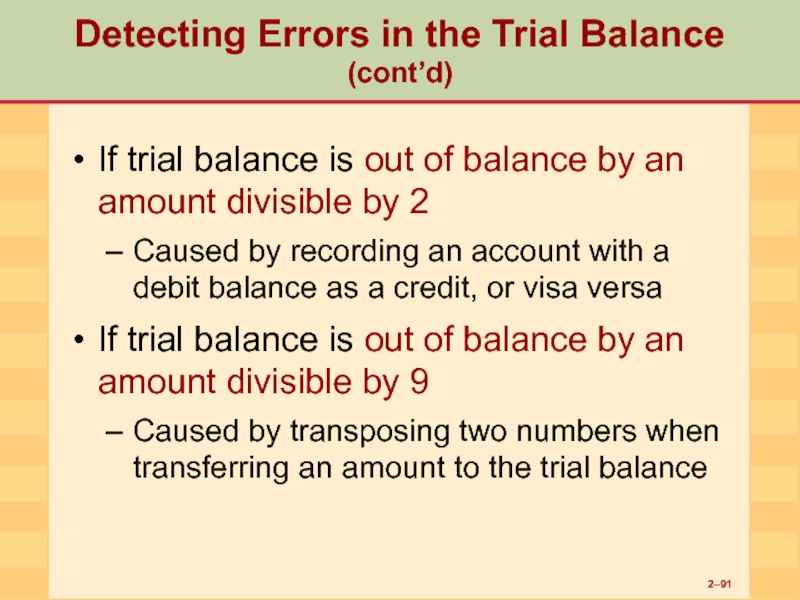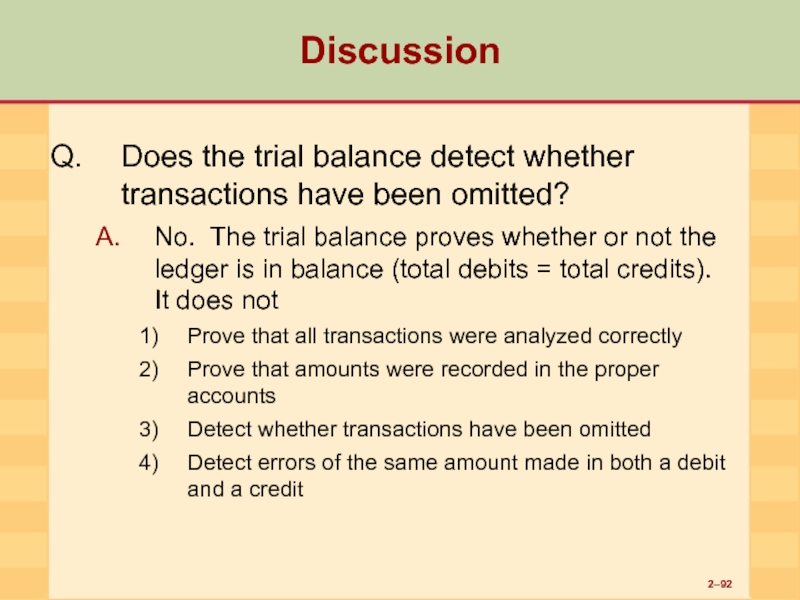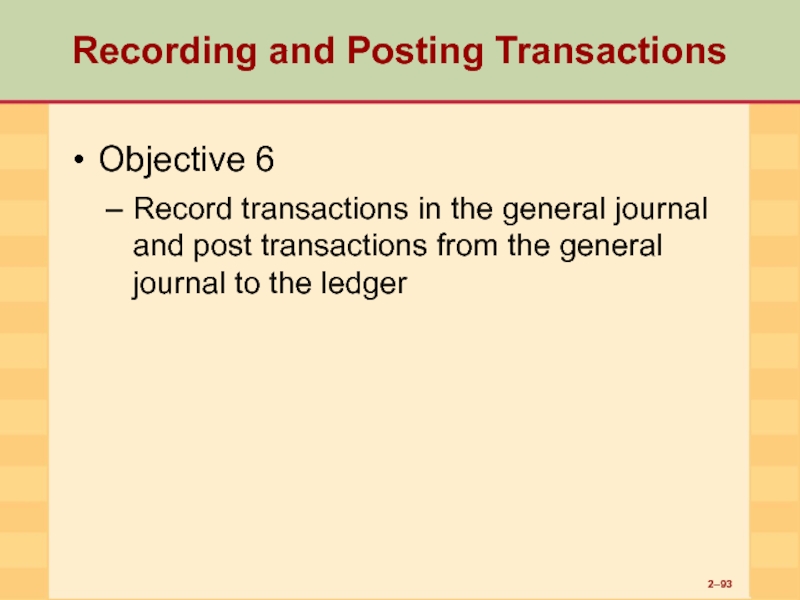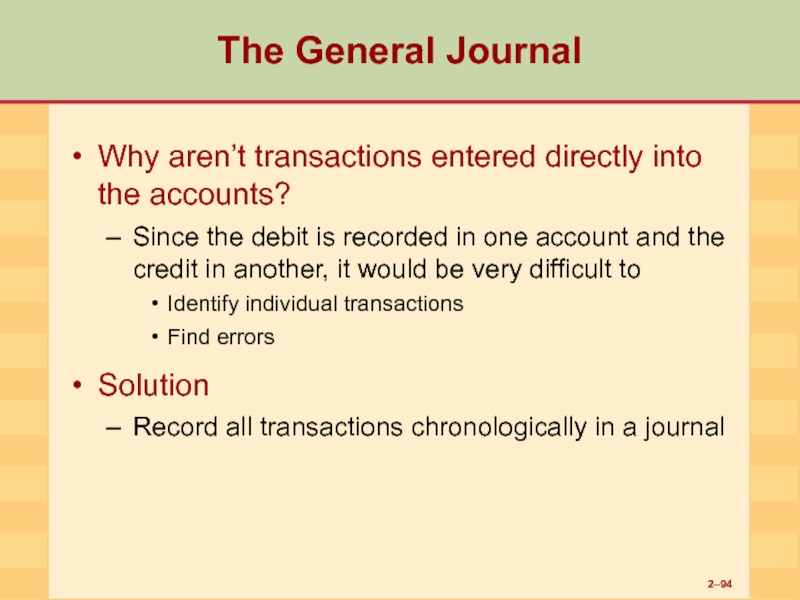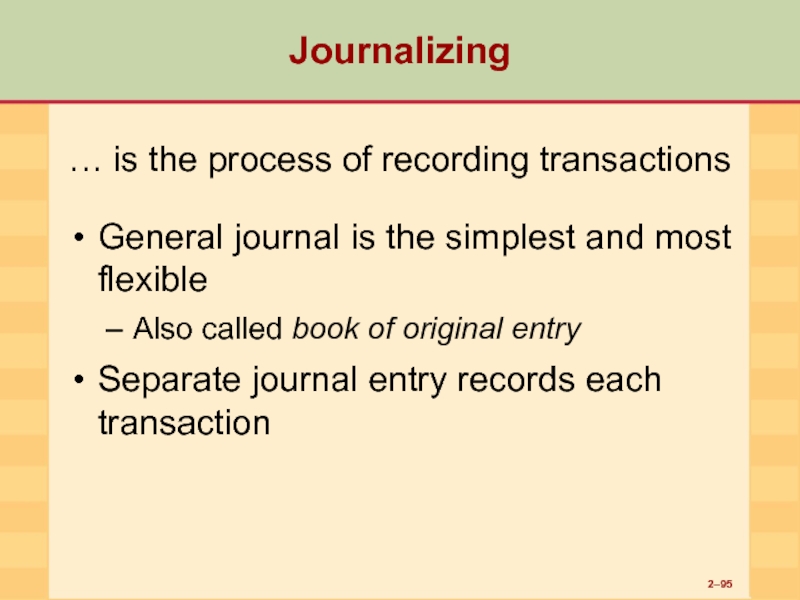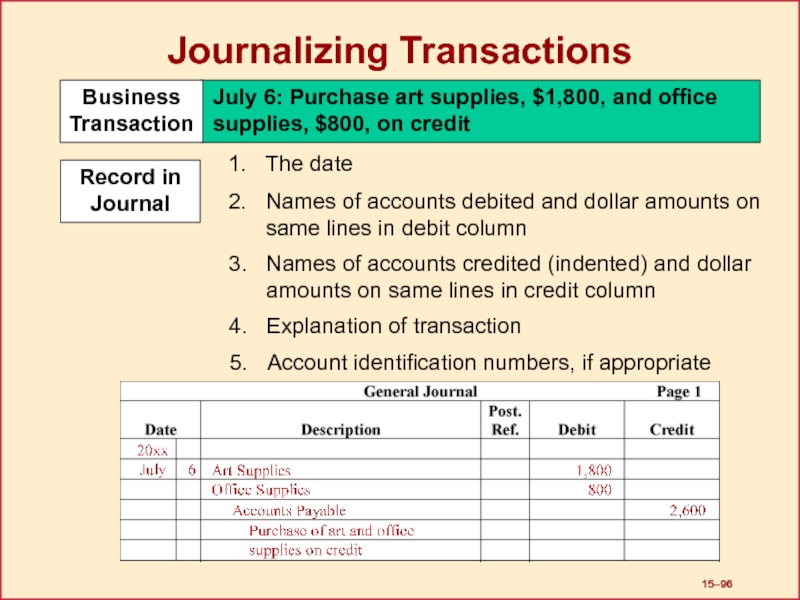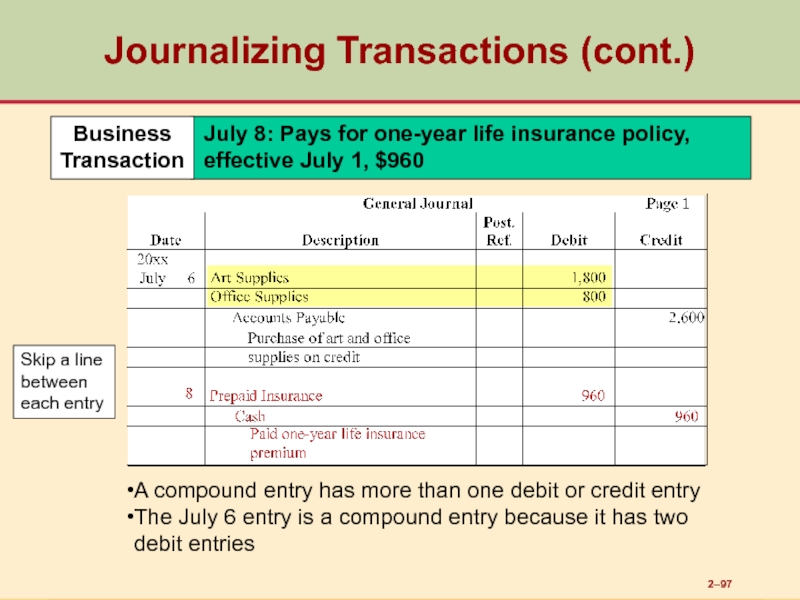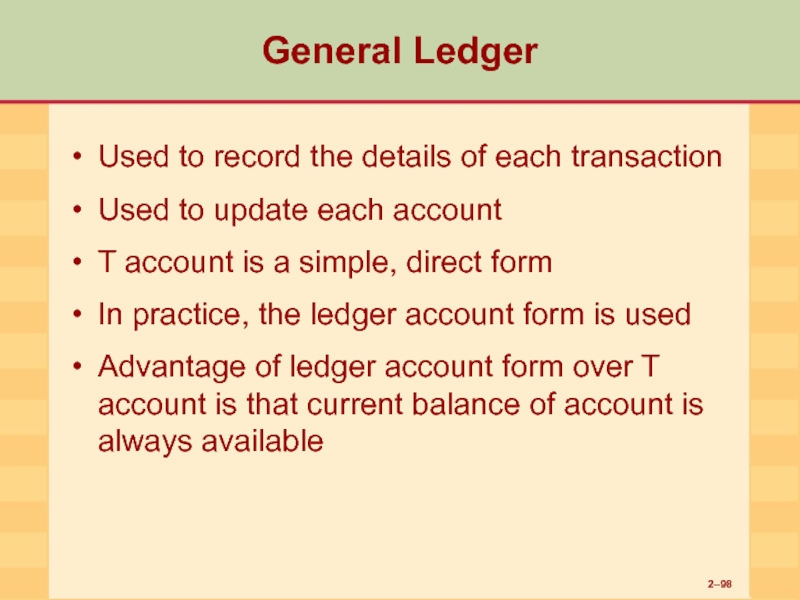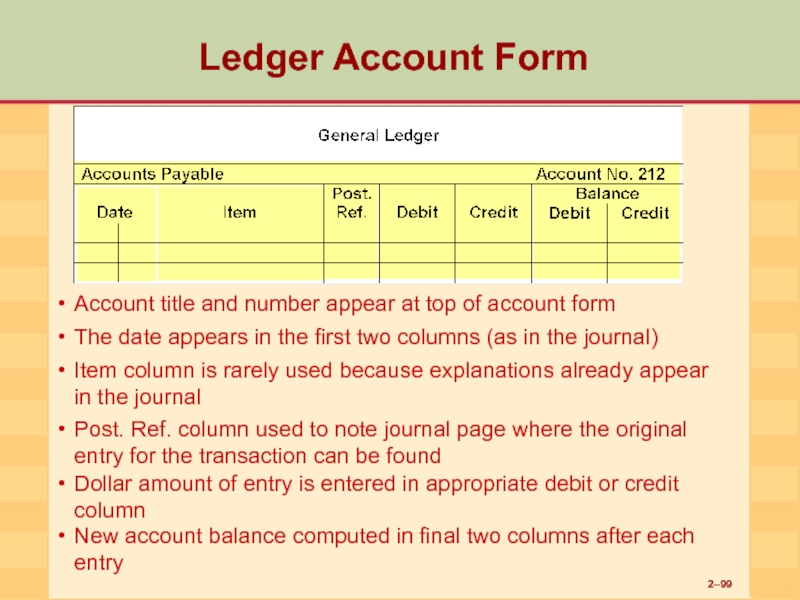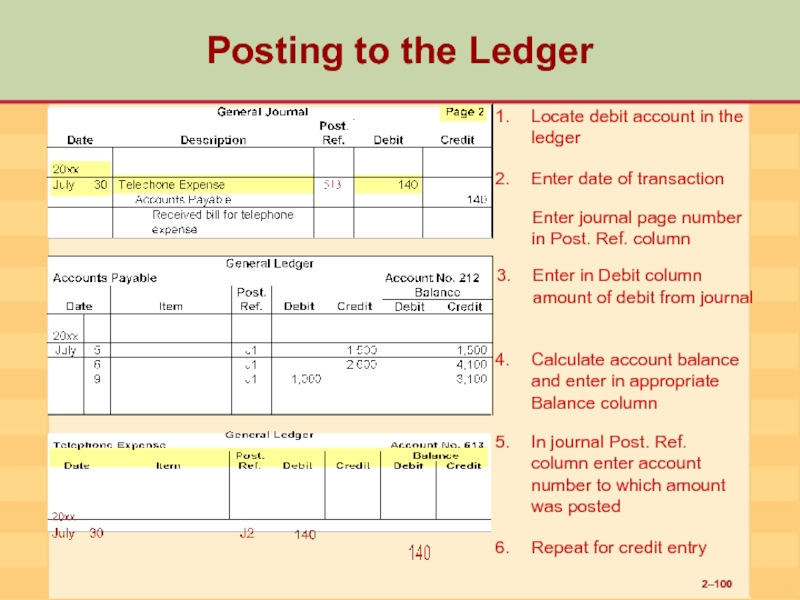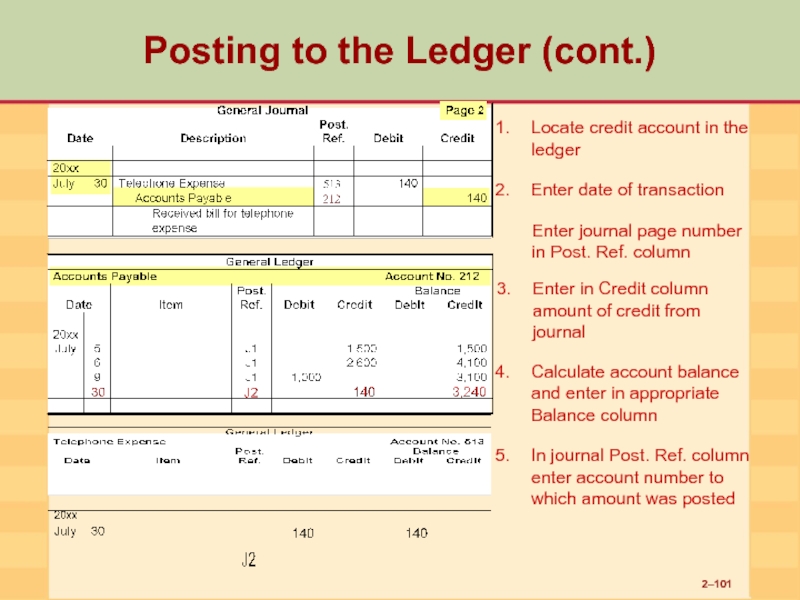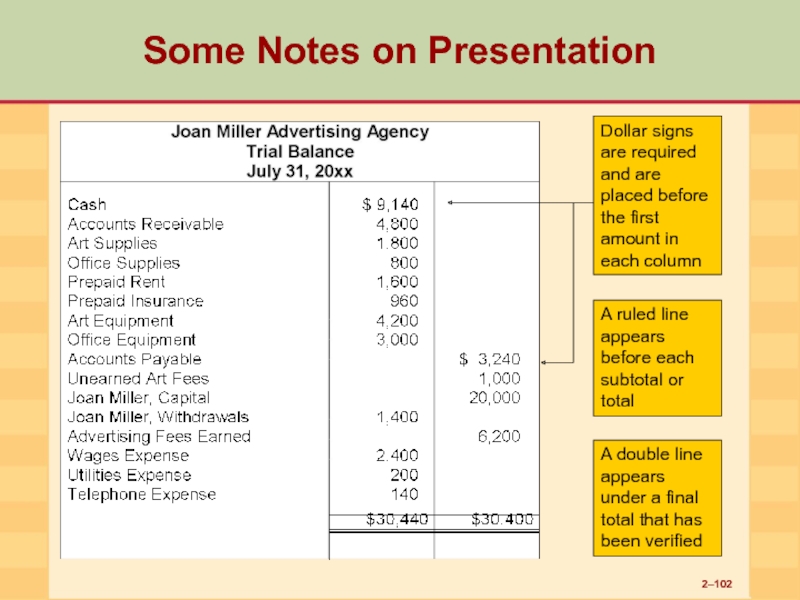- Главная
- Разное
- Дизайн
- Бизнес и предпринимательство
- Аналитика
- Образование
- Развлечения
- Красота и здоровье
- Финансы
- Государство
- Путешествия
- Спорт
- Недвижимость
- Армия
- Графика
- Культурология
- Еда и кулинария
- Лингвистика
- Английский язык
- Астрономия
- Алгебра
- Биология
- География
- Детские презентации
- Информатика
- История
- Литература
- Маркетинг
- Математика
- Медицина
- Менеджмент
- Музыка
- МХК
- Немецкий язык
- ОБЖ
- Обществознание
- Окружающий мир
- Педагогика
- Русский язык
- Технология
- Физика
- Философия
- Химия
- Шаблоны, картинки для презентаций
- Экология
- Экономика
- Юриспруденция
The Double-Entry System презентация
Содержание
- 1. The Double-Entry System
- 2. 2– Measurement Issues Objective 1 Explain, in
- 3. 2– Measuring Business Transactions Once accountants have
- 4. 2– Measurement Issues Recognition issue Valuation issue
- 5. 2– The Recognition Issue Recognition means the
- 6. 2– Point of Recognition for Sales and
- 7. 2– Business Event versus Business Transaction Business
- 8. 2– Business Events That …
- 9. 2– The Valuation Issue Focuses on assigning
- 10. 2– Cost Principle The principle that a
- 12. 2– Analyzing Information Recall - the cost
- 13. 2– The Classification Issue Classification is the
- 14. 2– Discussion What three issues underlie most
- 15. 2– Accounts and the Chart of Accounts
- 16. 2– Accounts Used to record transaction data
- 17. 2– General Ledger Group of company accounts
- 18. 2– Chart of Accounts List of account
- 19. Example of Account Numbering 1000 - 1999:
- 20. 2– Owner's Equity Accounts Revenue and expense
- 21. 2– Account Titles Should describe what is
- 22. 2– Discussion What is an account? Account
- 23. 2– The Double-Entry System: The Basic Method
- 24. 2– Example:
- 25. 2– Principle of Duality Each transaction recorded
- 26. 2–
- 27. 2–
- 29. 2–
- 30. 2– Footings and the Account Balance Footings
- 31. 2– Footings and the Account Balance (cont’d)
- 32. 2– Analyzing and Processing Transactions Rules of
- 33. 2– Keeping the Accounting Equation in
- 34. 2– Accounts and the Accounting Equation
- 35. 2– Accounts and the Accounting Equation
- 36. 2–
- 37. 2– Components of Owner's Equity Capital Withdrawals Revenues Expenses
- 38. 2– Owner's Equity Capital – Withdrawals
- 39. 2– Capital Withdrawals Revenues
- 40. 2– Rearranging the Accounting Equation Assets =
- 41. 2– Analyzing and Processing Transactions Analyze the
- 42. 2– Analyzing and Processing Transactions (cont’d) Record
- 43. 2– Recording a Transaction in Journal Form
- 44. 2– Posting Journal Entry to Accounts
- 45. 2– Discussion Why do debits, which decrease
- 46. 2– Transaction Analysis Illustrated Objective 4 Apply
- 47. 2– Investment in Company Business Transaction
- 48. 2–
- 49. 2– Purchase Assets Business Transaction Step
- 50. 2–
- 51. 2– Purchases Business Transaction Step 1
- 52. 2–
- 53. 2– Purchases Business Transaction Step 1
- 54. 2– Purchases Business Transaction Step 1
- 55. 2–
- 56. 2– Purchases Business Transaction Step 1
- 57. 2–
- 58. 2– Purchase Assets Business Transaction Step
- 59. 2–
- 60. 2– Partial Payment of Liability Business
- 61. 2–
- 62. 2– Revenues Business Transaction Step 1
- 63. 2–
- 64. 2– Expenses Business Transaction Step 1
- 65. 2–
- 66. 2– Revenue Business Transaction Step 1
- 67. 2–
- 68. 2– Revenue Business Transaction Step 1
- 69. 2–
- 70. 2– Expenses Business Transaction Step 1
- 71. 2–
- 72. 2– Expenses Business Transaction Step 1
- 73. 2–
- 74. 2– Expenses Business Transaction Step 1
- 75. 2–
- 76. 2– Withdrawals Business Transaction Step 1
- 77. 2–
- 78. 2– Discussion Why does Joan Miller record
- 79. 2– The Trial Balance Objective 5 Prepare
- 80. 2– The Trial Balance For every amount
- 81. 2– Normal Account Balances Normal balance means
- 82. 2– Debit Credit (–)
- 83. 2– Normal Account Balances and the Accounting
- 84. 2–
- 85. 2– Steps in Preparing a Trial Balance
- 86. 2– Joan Miller Advertising Agency Determine the
- 87. 2–
- 88. 2–
- 89. 2– Trial Balance (cont’d.) The trial balance
- 90. 2– Detecting Errors in the Trial Balance
- 91. 2– Detecting Errors in the Trial Balance
- 92. 2– Does the trial balance detect whether
- 93. 2– Recording and Posting Transactions Objective 6
- 94. 2– The General Journal Why aren’t transactions
- 95. 2– Journalizing … is the process of
- 96. 15– Journalizing Transactions The date Names of
- 97. 2– Journalizing Transactions (cont.) A
- 98. 2– General Ledger Used to record the
- 99. 2–
- 100. 2– Posting to the Ledger
- 101. 2– Posting to the Ledger (cont.)
- 102. 2– Some Notes on Presentation A ruled
Слайд 22–
Measurement Issues
Objective 1
Explain, in simple terms, the generally accepted ways of
Слайд 32–
Measuring Business Transactions
Once accountants have determined a
transaction has occurred, they
When the transaction occurred
The recognition issue
What value to place on the transaction
The valuation issue
How to categorize the components of the transaction
The classification issue
Слайд 42–
Measurement Issues
Recognition issue
Valuation issue
Classification issue
These issues underlie almost every major decision
Controversies exist; solutions are not cut and dried
Слайд 52–
The Recognition Issue
Recognition means the recording of a transaction
Refers to
Point of recognition is important because it affects the financial statements
Слайд 62–
Point of Recognition for Sales and Purchases
Sales and purchases of products
Usually
Or, may set up a recognition point
Predetermined time at which a transaction should be recorded
Sales and purchases of services
Usually recognized when services have been performed
If services are performed over a long period of time, may set up billing at specific points of time
Transaction recorded at each billing
Слайд 72–
Business Event versus Business Transaction
Business Event
Any occurrence related to the course
Business Transaction
Economic event that affects the financial position of a business entity
Слайд 92–
The Valuation Issue
Focuses on assigning a monetary value to a transaction
Most
According to GAAP, use original cost
Also called historical cost
Practice of recording transactions at cost follows the cost principle
Слайд 102–
Cost Principle
The principle that a purchased asset should be recorded at
Cost
Exchange price associated with a business transaction at the point of recognition
Exchange price
Amount a buyer is willing to pay and a seller is willing to receive
Is objective (not influenced by emotion or personal feelings)
Cost principle is used because cost is verifiable
Слайд 11
Applying the Cost Principle
Company B
Company A
Company A purchases building for $80,000
Company
Company A
Records sale of building at sales price (exchange price) of $110,000 and profit or loss is recognized
Company B
Records purchase of building at cost (exchange price) of $110,000
Company A
Records purchase of building at original cost (exchange price) of $80,000
Company A sells building to Company B for $110,000
Only amounts involved in business transactions (exchanges of value) are recorded in the company books
Слайд 122–
Analyzing Information
Recall - the cost principle requires that a purchased asset
Exchange price
The amount a buyer is willing to pay and a seller is willing to receive for an exchange of value
Is objective (not influenced by emotion or personal feelings)
Слайд 132–
The Classification Issue
Classification is the process of assigning transactions to the
Proper classification depends on
Correctly analyzing the effect of each transaction on the business
Maintaining a system of accounts that reflects that effect
The classification issue refers to the uncertainties associated with assigning transactions to the appropriate accounts
Слайд 142–
Discussion
What three issues underlie most accounting decisions?
The recognition issue
When a transaction
The valuation issue
What value should be placed on the transaction
The classification issue
How the components should be categorized
Слайд 152–
Accounts and the Chart of Accounts
Objective 2
Describe the chart of accounts
Слайд 162–
Accounts
Used to record transaction data
Record data in a usable form
Data can
Separate account used for each
Asset
Liability
Component of owner’s equity (includes revenues and expenses)
Слайд 172–
General Ledger
Group of company accounts
Sometimes simply referred to as the ledger
Two
Manual system
Each account on separate page or card
Pages or cards placed together in book or file
Computerized system
Accounts maintained on magnetic tapes or disks
Слайд 182–
Chart of Accounts
List of account numbers with corresponding account names
Helps identify
First digit in account number refers to major financial statement classification
Assets
Liabilities
Owner's equity
Revenues
Expenses
Слайд 19Example of Account Numbering
1000 - 1999: asset accounts
2000 - 2999: liability
3000 - 3999: equity accounts
4000 - 4999: revenue accounts
5000 - 5999: cost of goods sold
6000 - 6999: expense accounts
7000 - 7999: other revenue (for example, interest income)
8000 - 8999: other expense (for example, income taxes)
2–
Слайд 202–
Owner's Equity Accounts
Revenue and expense accounts separated from other owner's equity
Important for legal and financial reporting purposes
Owner's equity accounts represent how much interest in the assets of a company the owner has
Law requires that Capital and Withdrawal accounts be separate from revenues and expenses for tax and financial reporting
Management needs a detailed breakdown of revenues and expenses for budgeting and operating purposes
Слайд 212–
Account Titles
Should describe what is recorded in the account
An account
Identify account’s classification as asset, liability, owner's equity, revenue, or expense
Identify the type of transaction that gave rise to the account
Different companies may use different account names for the same account
Слайд 222–
Discussion
What is an account?
Account
Means by which management accumulates the effects of
Basic storage unit for accounting data
Q. How is an account related to the ledger?
The ledger is a file or book in which the company’s accounts are kept
Слайд 232–
The Double-Entry System:
The Basic Method of Accounting
Objective 3
Define double-entry system and
Слайд 242–
Example:
Pay cash to purchase supplies
Cash paid = effort, sacrifice, source
Supplies received
Double-Entry System
Based on principle of duality
Every economic event has two aspects that balance, or offset, each other
The two aspects represent
Effort and reward
Sacrifice and benefit
Source and use
Слайд 252–
Principle of Duality
Each transaction recorded with at least one debit and
Total amount of debits = total amount of credits
Whole system always in balance
All accounting systems based on principle of duality
Слайд 262–
The T Account
Three parts
Title of Account
A left side, called the
Debit
(left) side
A right side, called the credit side
Credit
(right) side
A title that describes the account
Слайд 272–
The T Account Illustrated
Title of Account
Debit
(left) side
Credit
(right) side
In Chapter 1, Shannon
Transactions can be summarized in T accounts
Record cash receipts (increases) on debit (left) side
Record cash payments (decreases) on credit (right) side
Cash
Cash Receipts
(+)
Cash Payments
(–)
Слайд 28
Shannon Realty
Deposited $50,000 in a bank account in the name of
Purchased a lot for $10,000 and a small building on a lot for $25,000
Paid $200 of the $500 owed for supplies
Earned and received a commission of $1,500 in cash
50,000
(2) 35,000
(5) 1,500
Transaction 3 does not affect the Cash account
Purchased office supplies for $500 on credit
(4) 200
Слайд 292–
50,000
(2)
(5) 1,500
(4) 200
Shannon Realty (cont’d)
Received $1,000 from client for commission earned earlier in the month
Paid $1,000 to rent equipment for office
Paid $400 in wages to part-time helper
Owner withdrew $600 in cash for personal use
(7) 1,000
Transaction 6 does not affect the Cash account
A $2,000 commission is earned, to be received later
Transaction 10 does not affect the Cash account
Liability of $300 for utilities expense is recorded
(8) 1,000
(9) 400
(11) 600
Слайд 302–
Footings and the Account Balance
Footings
Working totals of columns
Calculated at end
Account balance
Difference between total debit footing and total credit footing
Also simply called the balance
Debit balance recorded on left side of T account
Credit balance recorded on right side of T account
Слайд 312–
Footings and the Account Balance (cont’d)
Cash
(1)
(5) 1,500
(7) 1,000
(2) 35,000
(4) 200
(8) 1,000
(9) 400
(11) 600
52,500
37,200
Bal. 15,300
Total the debit side of the T account
Total the credit side of the T account
Слайд 322–
Analyzing and Processing Transactions
Rules of double-entry bookkeeping
Every transaction affects at
At least one account is debited and at least one account is credited
Total debits must equal total credits
For each transaction
For whole system (all accounts as a group)
Слайд 332–
Keeping the Accounting Equation
in Balance
For the accounting equation to stay
Assets = Liabilities + Owner's Equity
Increase both sides of equal sign by same amount
Decrease both sides of equal sign by same amount
Increase and decrease one side of equal sign by same amount
Слайд 342–
Accounts and the Accounting Equation
Assets = Liabilities + Equity
Debit
for
Increases
(+)
Assets increase with debits
Liabilities and owner's equity increase with credits
Assets decrease with credits
Credit
for
Decreases
(–)
Liabilities and owner's equity decrease with debits
Слайд 352–
Accounts and the Accounting Equation (cont’d)
500
500
1,000
If a debit increases
a credit must increase
liabilities or owner's equity
for the accounting equation to remain in balance
1,000
1,500 = 500 + 1,000
Owner's
Assets = Liabilities + Equity
Слайд 362–
Assets = Liabilities + Equity
500
500
1,000
1,000
Accounts and the Accounting Equation (cont’d)
If a credit increases liabilities
a debit must decrease
liabilities or owner's equity
for the accounting equation to remain in balance
750
750
250
250
1,500 = 1,250 + 250
Слайд 382–
Owner's Equity
Capital – Withdrawals + Revenues – Expenses
Effects of Withdrawals, Revenues,
Withdrawals and expenses decrease owner's equity
Transactions that increase withdrawals or expenses decrease owner's equity
+ Revenues
Revenues increase owner's equity
Transactions that increase revenues increase owner's equity
Слайд 392–
Capital Withdrawals Revenues Expenses
Assets = Liabilities + Owner's Equity
Now that the components of owner's equity have been identified
The accounting equation can be expanded to include these components
And their effects on owner's equity are understood
Expanding the Accounting Equation
Capital – Withdrawals + Revenues – Expenses
Слайд 402–
Rearranging the Accounting Equation
Assets = Liabilities + Capital – Withdrawals +
Because Withdrawals and Expenses are deductions from owner's equity, move them to the left side of the equation
Assets + Withdrawals + Expenses = Liabilities + Capital + Revenues
Accounts increased by debits
Accounts increased by credits
=
Слайд 412–
Analyzing and Processing Transactions
Analyze the transaction
Transactions are supported by source documents
Determine
Apply the rules of double entry
Debits increase assets and decrease liabilities and owner's equity
Credits decrease assets and increase liabilities and owner's equity
Слайд 422–
Analyzing and Processing Transactions (cont’d)
Record the entry
Record in chronological order in
Post the entry
Transfer dates and amounts from journal to proper accounts in ledger
Prepare the trial balance
Confirms that accounts are still in balance
Слайд 432–
Recording a Transaction in
Journal Form
Date
Debit account and debit amount recorded on
Credit account and credit amount recorded on next line, indented
Слайд 452–
Discussion
Why do debits, which decrease owner's equity, also increase withdrawals and
Assets = Liabilities + Capital – Withdrawals + Revenues – Expenses
Withdrawals and expenses are deductions from owner’s equity
Transactions that increase withdrawals and expenses decrease owner's equity
Owner's equity is decreased by debits
Слайд 462–
Transaction Analysis Illustrated
Objective 4
Apply the steps for transaction analysis and processing
Слайд 472–
Investment in Company
Business
Transaction
Step 1
Analyze
Step 2
Apply rules
Step 3
Record
July 1: Joan Miller
Increase in assets
Increase in owner’s equity
Debits increase assets (Cash)
Credits increase owner’s equity (Joan Miller, Capital)
Слайд 492–
Purchase Assets
Business
Transaction
Step 1
Analyze
Step 2
Apply rules
Step 3
Record
July 2: Rents office and
Increase in assets
Decrease in assets
Debits increase assets (Prepaid Rent)
Credits decrease assets (Cash)
Слайд 512–
Purchases
Business
Transaction
Step 1
Analyze
Step 2
Apply rules
Step 3
Record
July 3: Purchases art equipment for
Increase in assets
Decrease in assets
Debits increase assets (Art Equipment)
Credits decrease assets (Cash)
Слайд 532–
Purchases
Business
Transaction
Step 1
Analyze
Step 2
Apply rules
Step 3
Record
July 4: Orders art supplies, $1,800,
No entry because transaction has not occurred
Слайд 542–
Purchases
Business
Transaction
Step 1
Analyze
Step 2
Apply rules
Step 3
Record
July 5: Purchases office equipment, $3,000.
Increase in assets
Decrease in assets
Increase in liabilities
Debits increase assets (Office Equipment)
Credits decrease assets (Cash)
Credits increase liabilities (Accounts Payable)
Слайд 562–
Purchases
Business
Transaction
Step 1
Analyze
Step 2
Apply rules
Step 3
Record
July 6: Purchases art supplies, $1,800,
Increase in assets
Increase in liabilities
Debits increase assets (Art Supplies and Office Supplies)
Credits increase liabilities (Accounts Payable)
Слайд 582–
Purchase Assets
Business
Transaction
Step 1
Analyze
Step 2
Apply rules
Step 3
Record
July 8: Pays for one-year
Increase in assets
Decrease in assets
Debits increase assets (Prepaid Insurance)
Credits decrease assets (Cash)
Слайд 602–
Partial Payment of Liability
Business
Transaction
Step 1
Analyze
Step 2
Apply rules
Step 3
Record
July 9: Pays
Decrease in liabilities
Decrease in assets
Debits decrease liabilities (Accts. Payable)
Credits decrease assets (Cash)
Слайд 622–
Revenues
Business
Transaction
Step 1
Analyze
Step 2
Apply rules
Step 3
Record
July 10: Performs service by placing
Increase in assets
Increase in owner’s equity
Debits increase assets (Cash)
Credits increase owner’s equity (Advertising Fees Earned)
Слайд 642–
Expenses
Business
Transaction
Step 1
Analyze
Step 2
Apply rules
Step 3
Record
July 12: Pays secretary two weeks’
Decrease in owner’s equity (increase in expenses)
Decrease in assets
Debits decrease owner’s equity (increase Wages Expense)
Credits decrease assets (Cash)
Слайд 662–
Revenue
Business
Transaction
Step 1
Analyze
Step 2
Apply rules
Step 3
Record
July 15: Accepts advance fee for
(Payment received for future services)
Increase in assets
Increase in liabilities
Debits increase assets (Cash)
Credits increase liabilities (Unearned Art Fees)
Слайд 682–
Revenue
Business
Transaction
Step 1
Analyze
Step 2
Apply rules
Step 3
Record
July 19: Performs advertising service for
(Revenue earned, to be received later)
Increase in assets
Increase in owner's equity (revenues)
Debits increase assets (Accounts Receivable)
Credits increase owner's equity (Advertising Fees Earned)
Слайд 692–
Step 4
Post
Debit
Accts. Receivable 4,800
Credit
Ad. Fees Earned 4,800
Owner's Equity
Слайд 702–
Expenses
Business
Transaction
Step 1
Analyze
Step 2
Apply rules
Step 3
Record
July 26: Pays secretary two more
Decrease in owner's equity (increase in expenses)
Decrease in assets
Debits decrease owner's equity (increase Wages Expense)
Credits decrease assets (Cash)
Слайд 722–
Expenses
Business
Transaction
Step 1
Analyze
Step 2
Apply rules
Step 3
Record
July 29: Receives and pays utility
Decrease in owner's equity (increase in expenses)
Decrease in assets
Debits decrease owner's equity (increase Utilities Expense)
Credits decrease assets (Cash)
Слайд 742–
Expenses
Business
Transaction
Step 1
Analyze
Step 2
Apply rules
Step 3
Record
July 30: Receives (but does not
(Expense incurred, to be paid later)
Decrease in owner's equity (increase in expenses)
Increase in liabilities
Debits decrease owner's equity (increase Telephone Expense)
Credits increase liabilities (Accts. Payable)
Слайд 762–
Withdrawals
Business
Transaction
Step 1
Analyze
Step 2
Apply rules
Step 3
Record
July 31: Joan Miller withdraws $1,400
Decrease in owner's equity
Decrease in assets
Debits decrease owner's equity (increase Joan Miller, Withdrawals)
Credits decrease assets (Cash)
Слайд 772–
Step 4
Post
Owner's Equity + Liabilities
Debit
Joan Miller,
Withdrawals 1,400
Credit
Cash 1,400
Слайд 782–
Discussion
Why does Joan Miller record the expense for the telephone bill
An expense has been incurred for telephone services used
An obligation to pay exists
Joan Miller records the expense and the liability for the telephone service
Слайд 792–
The Trial Balance
Objective 5
Prepare a trial balance and describe its value
Слайд 802–
The Trial Balance
For every amount debited, an equal amount must be
Result: The total of debits and credits for all the T accounts must be equal
Trial balance is prepared to test this
Usually prepared at the end of a month or an accounting period
Can be prepared anytime
Слайд 812–
Normal Account Balances
Normal balance means usual balance
Refers to whether increases in
Accounts that are increased with debits have a normal debit balance
Accounts that are increased with credits have a normal credit balance
An account may have an “abnormal” balance
Copy into the trial balance as it stands
Слайд 822–
Debit Credit
(–) (+)
Debit Credit
(–)
Debit Credit
(+) (–)
Assets = Liabilities + Owner's Equity
Recall the basic accounting equation:
Assets are increased by debits
Liabilities and owner's equity are increased by credits
Normal Account Balances and the Accounting Equation
Слайд 832–
Normal Account Balances and the Accounting Equation (cont’d)
Assets = Liabilities +
However, when the basic accounting equation is expanded to include all the components of owner's equity,
We see that Withdrawals and expense accounts reduce owner's equity
Слайд 842–
Normal Account Balances and the Accounting Equation (cont’d)
Accounts increased by
credits
Accounts
Assets + Withdrawals + Expenses = Liabilities + Capital + Revenues
Withdrawals and expenses can be moved to the left side of the equation so that
Accounts with a
normal debit balance
Accounts with a
normal credit balance
Слайд 852–
Steps in Preparing a Trial Balance
List each T account that has
Record debit balances in the left column
Record credit balances in the right column
List accounts in the order that they appear in the ledger
Add each column
Compare the column totals
Total debits should equal total credits
Слайд 862–
Joan Miller Advertising Agency
Determine the T account balances for Joan Miller
Use footings
Transfer account balances to the trial balance
Total each column
Compare column totals
Слайд 872–
Owner's Equity + Liabilities
Determine account balances
Joan Miller Advertising Agency
Слайд 882–
Trial Balance
Record debit balances in the left column
Record credit balances in
The trial balance proves the ledger is in balance
Total debits = Total credits
Add each column
Слайд 892–
Trial Balance (cont’d.)
The trial balance proves whether or not the ledger
Total of all debits recorded = Total of all credits recorded
What it does not do
Prove that all transactions were analyzed correctly
Prove that amounts were recorded in the proper accounts
Detect whether transactions have been omitted
Detect errors of the same amount made in both a debit and a credit
Слайд 902–
Detecting Errors in the Trial Balance
If the debit and credit columns
A debit entered as a credit, or visa versa
An incorrectly computed account balance
Error in carrying the account balance to the trial balance
Trial balance summed incorrectly
Слайд 912–
Detecting Errors in the Trial Balance (cont’d)
If trial balance is out
Caused by recording an account with a debit balance as a credit, or visa versa
If trial balance is out of balance by an amount divisible by 9
Caused by transposing two numbers when transferring an amount to the trial balance
Слайд 922–
Does the trial balance detect whether transactions have been omitted?
No. The
Prove that all transactions were analyzed correctly
Prove that amounts were recorded in the proper accounts
Detect whether transactions have been omitted
Detect errors of the same amount made in both a debit and a credit
Discussion
Слайд 932–
Recording and Posting Transactions
Objective 6
Record transactions in the general journal and
Слайд 942–
The General Journal
Why aren’t transactions entered directly into the accounts?
Since the
Identify individual transactions
Find errors
Solution
Record all transactions chronologically in a journal
Слайд 952–
Journalizing
… is the process of recording transactions
General journal is the simplest
Also called book of original entry
Separate journal entry records each transaction
Слайд 9615–
Journalizing Transactions
The date
Names of accounts debited and dollar amounts on same
Names of accounts credited (indented) and dollar amounts on same lines in credit column
Explanation of transaction
Account identification numbers, if appropriate
Record in
Journal
Слайд 972–
Journalizing Transactions (cont.)
A compound entry has more than one debit or
The July 6 entry is a compound entry because it has two debit entries
Skip a line between each entry
Слайд 982–
General Ledger
Used to record the details of each transaction
Used to update
T account is a simple, direct form
In practice, the ledger account form is used
Advantage of ledger account form over T account is that current balance of account is always available
Слайд 992–
Ledger Account Form
Account title and number appear at top of account form
The date appears in the first two columns (as in the journal)
Item column is rarely used because explanations already appear in the journal
Post. Ref. column used to note journal page where the original entry for the transaction can be found
Dollar amount of entry is entered in appropriate debit or credit column
New account balance computed in final two columns after each entry
Слайд 1002–
Posting to the Ledger
Locate debit account in the ledger
Enter date of transaction
Enter journal page number in Post. Ref. column
Enter in Debit column amount of debit from journal
Calculate account balance and enter in appropriate Balance column
In journal Post. Ref. column enter account number to which amount was posted
Repeat for credit entry
Слайд 1012–
Posting to the Ledger (cont.)
In journal Post. Ref. column enter account number to which amount was posted
Enter in Credit column amount of credit from journal
Enter journal page number in Post. Ref. column
Locate credit account in the ledger
Enter date of transaction
Calculate account balance and enter in appropriate Balance column
Слайд 1022–
Some Notes on Presentation
A ruled line appears before each subtotal or
A double line appears under a final total that has been verified
